

MUSTANG NEWS
AT A TURNING POINT
After Charlie Kirk’s death, Cal Poly’s TPUSA chapter grows as students look to reshape its image

WISDOM

LEADERSHIP
ARCHANA PISUPATI Editor in Chief
JEREMY GARZA Managing Editor
AVIV KESAR Creative Director
CARLY HELTZEL News Editor
LEILA TOUATI Digital Director
MUSTANG NEWS
NEWS
Carly Heltzel News Editor
Bella Cox Assistant News Editor
Kaylin O’Connell Assistant News Editor
Caroline Ohlandt Print/Copy Editor
Abby Gorman
Alan Ko
Alexander Kohm
Angel Corzo
Ashley Strain
Ella Steere
Emilia Valero Martínez
Everlynn Dionne
Ginger Perez
Grace Gillio
Katy Clark
Maya Reiken
Nishita Mukherjee
Rebecca Von Tersch
Riya Minglani
Sam Fickett
Seth Pintar
OPINION
Landon Block Opinion Editor
Ash Pickett
Kaylie Wang
Larena Tannert
Maddie Kuhns
Mariko Garrett
Shayna Gayer
Madi Taylor Satire Columnist
Malia Mundy Satire Columnist
SPORTS
Amanda Avila Sports Content Director
Charlie Wiltsee Sports Editor
Dylan Allen Sports Video Editor
Ty Soria KCPR Sports Director
Joslen Jimenez Sports Social Media Manager
Matthew Muren Assistant Sports Editor
Ali Tafesh
Ava Acuesta
Rocco Brichler
Ava Keshtkar
Tyler O’Neal Westerweck
Amery Gill
Giada Mennucci
Noemi Bascara
Javin Hennessy
Jonathan Oliver Marburg
Andrew Aguinga
Paolo de Lancelotti
Lilia McCann
Ashley Strain
Quinlan TeSelle
Isabella Fierros
Luke Firoozye
Samantha Roach
Grace Nishanian
MUSTANG MEDIA GROUP
DESIGN
Aviv Kesar Creative Director
Meher Anklesaria
Natalia Celebrini
Ava Cheung
Ava Donaldson
Nhi Duong
Julia Hazemoto
Anika Loganathan
Kennedy Ray
Maya Shinden
Elena Vaughan
VIDEO
RJ Pollock MNTV Director
Parker Cinque
Sedona Harris
Mia Muzzi
Roman Noravian
Lauren Quijano
Chloë Schauermann
Dylan White
PHOTO
Soha Roy Photo Editor
Chloe Briote-Johnson
Emma Arredondo
Léa Bourges-Sevenier
Ben Robledo
Dijia Wang
Bia Sommers
Henry Miller
SOCIAL MEDIA
Gabrielle Ottaviano Social Media Manager
Chloe Gilb
Kaitlyn Knopf
Leah Orsini
Olivia Roman
Sedona Harris
Sydney Hecht
Maya Ziv
Eva Grove
DATA & INVESTIGATIONS
Alie Hall Data Editor
Julia Aptekar
Dilraj Dhaliwal
Beck Schemenauer
Amy Truong
Kaviya Veerasingam
Addie Weaver
Nicole Yee
BILINGUAL
Evelyn Santa Rosa Bilingual Editor
Suri Moreno
Addison Uhl
Isabella Beltran
KCPR
LEADERSHIP
Kat Orozco Content Director
Fiona Hastings News Director
Linnaea Marks Art Director
Amelia Nored Programming/Music Director
Jeremy Okmin Marketing Director
Ben Shane Podcast Manager
Bailee Isackson Photo Editor
Peyton Kelly Social Media Manager
KCPR NEWS
Fiona Hastings News Director
Riley Sullivan Assistant News Director
Ty Soria Sports Director
Delaney Ridder
Giselle Espinoza
Diego Puga
Evelyn Santa Rosa
Lauren Quijano
Ryan Giocamini
Dylan White
Mackena Locsin
Katy Clark
Randi Ingoglia
Alyssa Parikh
Amanda Avila
Brendan McCann
Charlie Wiltsee
Keegan Oates
Cayden Tan
Lia Griffiths
Lily Segelman
KCPR CONTENT
Kat Orozco Content Director
Marley Logan Editorial Assistant
Angie Stevens
Asmahan Karam
Ayla Boose
Ella Giuliani
Elsa Fuentes Virabyan
Emilia Pirir
George Meza
Iris Langen
Ishaani Dhanotra
Joe Forrestdavis
Olivia Nieporte
Lorenzo Cano
Max Brode
Rebecca Von Tersch
Sarah Jagielski
MMG BUSINESS
ADVERTISING & PR
Logan Teixeira Advertising Manager
Sydnie Bierma Special Sections Editor
Zoë Laureta Marketing and Public Relations Director
Nicolas Parrott Marketing Assistant
Ruby Beye Small Team Manager
Angie Ho Small Team Manager
ADVERTISING
DESIGNERS
Alex Nishida Design Team Manager
Christine Kim
Teia Kornienko
Lucas Winger
Maya Shinden
ADVERTISING ACCOUNT EXECUTIVES
Katelyn Carrera Senior Account Executive
Tara Davari KCPR Account Executive
Quinn Southall
Janalee Taguia
Julia Moore
Ruby Beye
Maz Reeder
Kyle Stefan
Wesley Bea
Akshay Perumal
SPECIAL SECTIONS
WRITERS
Sydnie Bierma Editor
Kate Roarke
Lillian Dolph
Allison Weil
Abby Moran
Julia Nunez
Samantha Orradre
Maxine St. Sure
Ishaani Dhanotra
Ava Welcher Ginger Perez



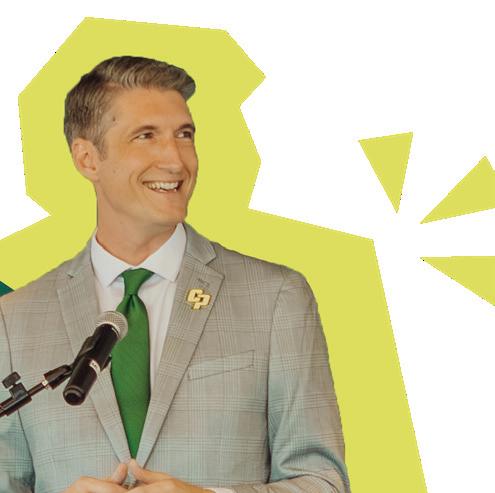
DEAR READERS,
DESIGNED BY ANIKA LOGANATHAN
Happy October! We are excited to welcome you, or welcome you back, to Mustang News and KCPR in print. Much of our newsroom is descending into the ‘Rory Gilmore journalist’ aesthetic, Archana included, paired with a ‘people-pleaser pumpkin spice latte’ from Linnaea’s Cafe this month. We are still hard at work in compiling content by students, for students to be heard.
Based on metrics and some bias, we see Mustang Media Group as one of the most influential organization on campus. One of our core roles as a media organization is to use our impact to seek the truth and report it. And the truth, is a lot of people get overlooked.
We’ve all been there: that moment in a conversation when you can tell the other person does not care about what you’re saying. Maybe they are having a bad day with a lot on their mind. Maybe there is someone cute on the other side of the room. Or maybe there are some undertones that you feel deep in the pit of your stomach.
In college media, change naturally happens every year as a new group of editors and staff take on new roles. Some policies and goals remain traditional, but others sometimes change overnight. Mustang Media Group is seeing a lot of evolution this year.
Our voices as student journalists are more important than ever. Nowadays, it feels like the only certainty is to expect uncertainty. We are striving to evolve to acknowledge and work past these undertones that make so many of us feel overlooked.
A major change coming to Mustang Media Group is Mustang News endorsements. Mustang News’ Editorial Board will begin to announce public endorsements of relevant public decisions. Along with our Opinion editor, Landon Block, we structured an endorsement policy that maintains our independent voices, while uplifting our own. Read more about our endorsement policy on the following page and join us as we continue shaping conversations that matter to students on our campus and in our community.
Please make the subject line [Letter to Editor, Topic — First name/Last name]. We require all letters to the editor to be signed with a name. LIKE

IN THIS ISSUE
We discussed last month’s MMG recap, and this month’s goals!
Throughout this issue, we are tackling issues that could affect all students. In California, a redistricting election will decide the future of congressional district maps through 2030 in response to Texas’ partisan redistricting earlier this year. In San Luis Obispo, presidential tariff orders have impacted local businesses and product circulation.
At Cal Poly, student experiences vary. The Cal Poly Turning Point USA chapter is restructuring and reimagining their club following the death of Charlie Kirk. We have new peers at the Cal Poly Maritime academy merging with the San Luis Obispo campus’s administration.
As the quarter is getting going, AI policies will surely be mentioned in syllabuses across departments and majors. The current fourth years are the first class to experiment with ChatGPT in their dorm rooms. We are dedicated to explaining unique student experiences through journalistic practices. A mission this
year is to have more of your stories featured throughout our printed and digital pages. If you are willing to share, we are willing to listen. We also want to reiterate as many times as possible that we want to hear from you. To submit a Letter to the Editor, email editorial@mustangmediagroup.com. Please make the subject line [Letter to Editor, Topic — First name/Last name]. We require all letters to the editor to be signed with a name.
Like listening to your news instead? Tune into our “Pod from the Editors” podcast where we discuss last month’s recap, and this month’s goals!
SINCERELY,
ARCHANA PISUPATI EDITOR-IN-CHIEF
JEREMY
GARZA MANAGING EDITOR
Mustang News will begin publishing endorsements
This policy change will expand our coverage to better inform the San Luis Obispo community on key public decisions
STATEMENT
BY
LANDON BLOCK DESIGNED BY NATALIA CELEBRINI
Landon Block is a political science senior and the Opinion Editor at Mustang News.
Mustang News’ Editorial Board will begin to announce public endorsements of relevant elections.
This change marks an expansion of Mustang News’ award-winning content to further serve the Cal Poly and San Luis Obispo community through thoughtful, intentional and thoroughly researched recommendations.
WHY ARE WE MAKING THIS CHANGE?
Historically, Mustang News has not officially endorsed candidates or propositions, although it has occasionally featured endorsements from individuals. However, it is common practice for many publications (such as The New York Times, the San Francisco Chronicle and the San Luis Obispo Tribune), including student-run publications (such as UCLA’s Daily Bruin and the University of Pennsylvania’s Daily Pennsylvanian), to publish endorsements.
As the Opinion Editor, I feel it is important to inform voters as thoroughly as possible, and that means expanding our content to include opinionated and well-reasoned endorsements for races that hold significant interest among Cal Poly and San Luis Obispo’s communities.
After many conversations with Mustang Media Group’s Editorin-Chief, Archana Pisupati, and Managing Editor, Jeremy Garza, we decided endorsements can be a powerful tool to shape public perception and inform voters about candidates and policies that impact their everyday lives.
While Mustang News reports on much of this information through fact-based news reporting, we also feel it is important to directly share our stance on certain critical public decisions. Moreover, we view this as an opportunity to provide a consistent and ongoing showcase of our publication’s principles, values and priorities. Our endorsements will directly reflect these foundational aspects of our institution.


WHO WILL BE DECIDING THE ENDORSEMENTS?
Endorsements will be decided, written and published by Mustang News’ Editorial Board. The voices in this group may fluctuate to include a number of columnists and editors to eliminate any potential conflicts of interest, either through newsroom reporting or outside associations. All members included in the decision-making process will be included in a disclaimer at the bottom of the article. Reporters covering issues for fact-based stories will not be included in conversations around endorsements.

HOW WILL THE ENDORSEMENTS BE DECIDED?
Endorsements will be decided through a rigorous research process, including but not limited to: fact-finding, policy analysis, character analysis and candidate interviews. A methodology, including the editors and staff involved in the decision, will be included in all endorsements.

In any situation, the editorial board will be composed to represent a diverse, informed and intentional voice in the best interest of the Cal Poly and San Luis Obispo community. Our endorsements may not, and likely will not, represent the individual beliefs of each individual Mustang News contributor or reader.
While endorsements may be influenced by public reporting, including that of Mustang News, the endorsement process will never interfere with how our newsroom reports on a given candidate or policy.
Furthermore, Mustang News never has, and never will, offer endorsements in exchange for advertisements or any quid pro quo incentives. Additionally, the Mustang Media Group business staff may accept politically affiliated advertisements. All Mustang News content is completely independent from these advertisements and the business and news entities exist separately for ethical reasons. Endorsements will not be associated with outside organizations or political parties.
WHAT DOES THIS MEAN FOR FUTURE COVERAGE?
This change in policy will have no impact on Mustang News’ typical election news reporting.
Endorsements will serve as additional content that voters can use to inform their choice when completing their ballot. They will be clearly marked under the Opinion section and the “Editorial Board” byline. Anyone interested is still encouraged to submit Letters to the Editor with their thoughts by emailing editorial@mustangmediagroup. com. These letters will be published by merit of argument and reasoning, not by whether they align with the editorial board’s endorsement.
As Opinion Editor, I understand the responsibility the editorial board holds in providing honest and thoughtful endorsements to our readers. On behalf of all of us, I thank you for your trust and promise we will take every measure to ensure we provide as many resources as possible to inform you.

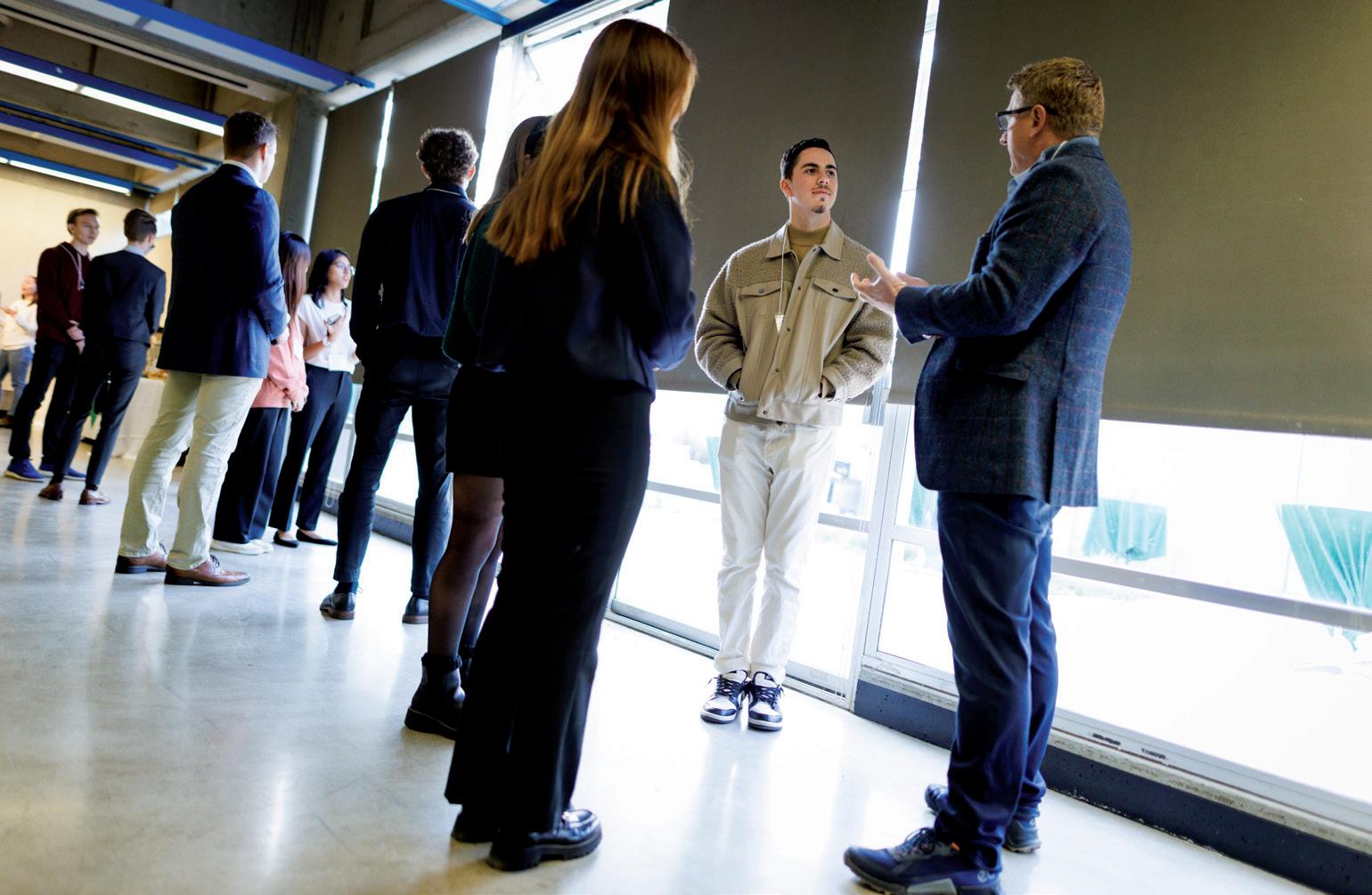















Downtown businesses navigate federal tariffs
Increased federal taxes on imports could present extra costs for small businesses that rely on foreign-manufactured goods
STORY BY SETH PINTAR DESIGNED BY MEHER ANKLESARIA
Scott Smith owns Central Coast Surfboards in San Luis Obispo, which carries several brands that manufacture their products overseas. Just two days after the Trump administration first introduced tariffs on imports from nearly 90 countries, he was concerned but remained hopeful for a policy reversal.
“We’re just sort of at the mercy of the world, right?” Smith said.
On April 2, President Donald Trump announced his “Liberation Day” tariffs on several countries that import goods into the United States. A tariff is a type of duty, a broad term used to describe taxes placed on goods coming from other countries. Tariffs are meant to regulate international trade, usually under some kind of pretext. The Trump administration’s goal was to correct trade imbalances that threaten America’s
industrial base and national security, as previously reported by Reuters.
Since then, the tariffs were removed and reapplied to different countries amid extensions for negotiations and questions over whether Trump overstepped his authority. As of publishing, new tariff rates have been in effect since Aug. 7, ranging from a baseline 10% rate to a maximum 50% rate, according to the government’s Harmonized Tariff Schedule.
Over the past six months, Smith said that costs to ship his foreign-manufactured inventory have risen, forcing him to raise prices on surfboards, skateboards and other accessories. He now joins other small business owners in downtown San Luis Obispo who are managing the costs of federal tariffs.
“We’ve got to keep the world turning,” Smith said. “Everything’s fluid and news changes fast.”
Two of the brands Central Coast Surfboards sells include Firewire and NSP SurfBoards. They produce
Unfortunately, it’s not just San Luis Obispo, a lot of businesses are having problems. The economy is bad.
ANTONIA ELHANJNASR
Owner of Antonia’s Pizza
boards in Thailand and are subject to a 19% tariff rate, according to the tariff schedule. Catch Surf, which produces boards in Taiwan, is subject to a similar 20% tariff rate, according to the tariff schedule.
Smith sells American-made surfboards from brands like Patterson and Surf Prescription, which are not touched by federal tariffs; however, there are advantages to the foreign-made boards. While he praised domestic suppliers who hand-craft their boards, he complimented foreign manufacturers whose machine-made boards are engineered for a quality riding experience.
“Overseas factories produce at very high levels, clean, consistent and reproducible, often at prices that are hard to match domestically,” Smith said.
Among supporters of the current tariff policies, there is a common call to buy American-made products.
“Buy American is the epitome of common-sense policy,” the White House wrote the day after Trump’s first tariffs were announced.
However, some domestic boards have seen an increase in cost from suppliers, according to Smith. He
doesn’t believe U.S. manufacturers can produce boards in the same quantity as foreign manufacturers. “If there’s stuff sourced in the U.S. that was comparable and good, then, yeah, we would get it, but there’s just not that much available,” Smith said. “Companies can’t ramp up manufacturing overnight.”
WORKING WITH SUPPLIERS TO KEEP PRICES LOW
Tariffs affecting imported food worry Jim Hessler, the owner of SLO Olive, which has been in business for 18 years.
Hessler sells products imported from Italy, such as balsamic vinegars, truffle oil, truffle salt and pasta. All of these products are subject to the 15% tariff rate on the European Union, according to the tariff schedule. Hessler said he is absorbing some of the tariff’s cost to keep prices down for customers. With the upcoming holiday season, he worries that
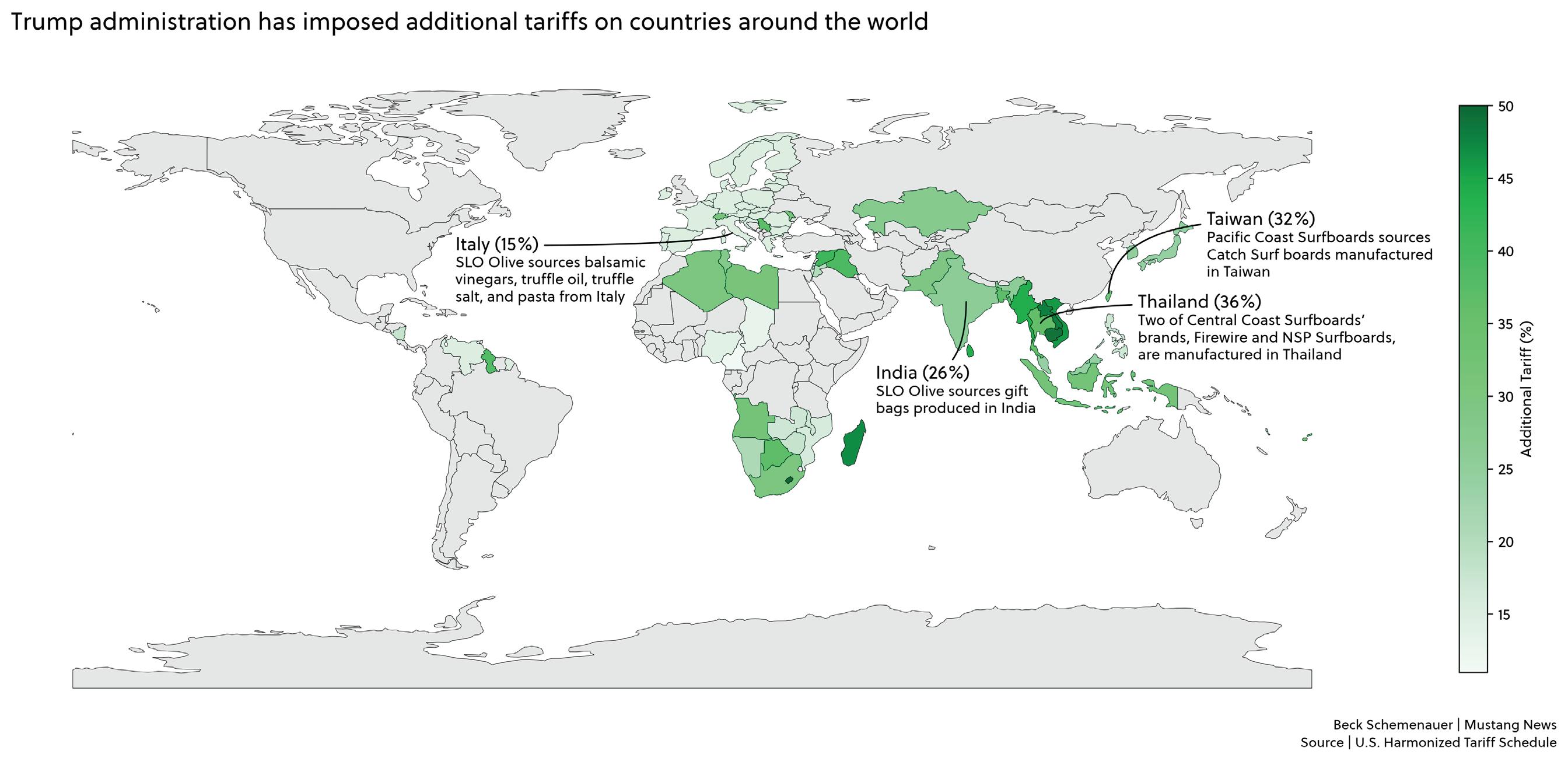
raising prices could hinder sales at a crucial time for his business.
Packaging for Hessler’s products is also subject to tariffs since they are not domestically produced. Some of his gift bags are made in India, which currently have a 25% tariff rate, according to the tariff schedule.
“I’m not going to worry about raising prices until we get into January,” Hessler said. “We do one third of our total business in a year during the last six weeks.”
Hessler hopes possible court action could undo the policy altogether. As of October 7, the Supreme Court is hearing arguments for cases that claim Trump’s tariffs exceed his power as the president, according to court filings.
With this current litigation against the Trump administration, Hessler hopes a favorable decision could turn this into a short-term problem.
EVEN FOR BUSINESSES LESS IMPACTED BY THE TARIFFS, OTHER CHALLENGES REMAIN
Ben Taylor, who owns Mama Ganache Artisan Chocolates, said tariffs impact him less, but his business faces other challenges.
Taylor buys chocolate in bulk, melts it down and turns it into various confections, such as peanut butter cups or hot chocolate. He also uses his purchasing power to resell chocolate to other small businesses, such as bakeries.
He has avoided tariffs by negotiating with brands offering either cheaper prices or a commitment to
pay the tariffs themselves. Overall, Taylor believes he’s “pretty lucky” to have avoided tariffs so far.
Still, he navigates other economic factors that raise the cost of goods. With an annual inflation rate of nearly 11%, chocolate globally has grown more expensive, as reported by CNBC. Taylor said he has noticed the higher prices.
“A couple of years ago, it was about four to five dollars per pound, now it’s about nine, 10, 11 dollars per pound,” Taylor said. “I don’t want to downplay tariffs, but they’re kind of the least of my worries.”
Antonia Elhajnasr, the owner of Antonia’s Pizza, said she hasn’t been affected by tariffs since her food is sourced from local farms. However, she saw a decrease in foot traffic downtown since November.
Elhajnasr worries about the local economy and thinks downtown needs to have more special events to attract customers.
“The only thing downtown really has is your farmers’ market, which is all-year-round, and then you have concerts in the park and the Christmas parade, but not really, not much else goes on downtown,” Elhajnasr said. “I personally think there should be more downtown, you know?”
She is also concerned about clothing shops downtown that are dealing with the combination of fewer customers and tariffs.
“Unfortunately, it’s not just San Luis Obispo,” Elhanjnasr said. “A lot of businesses are having problems. The economy is bad.”

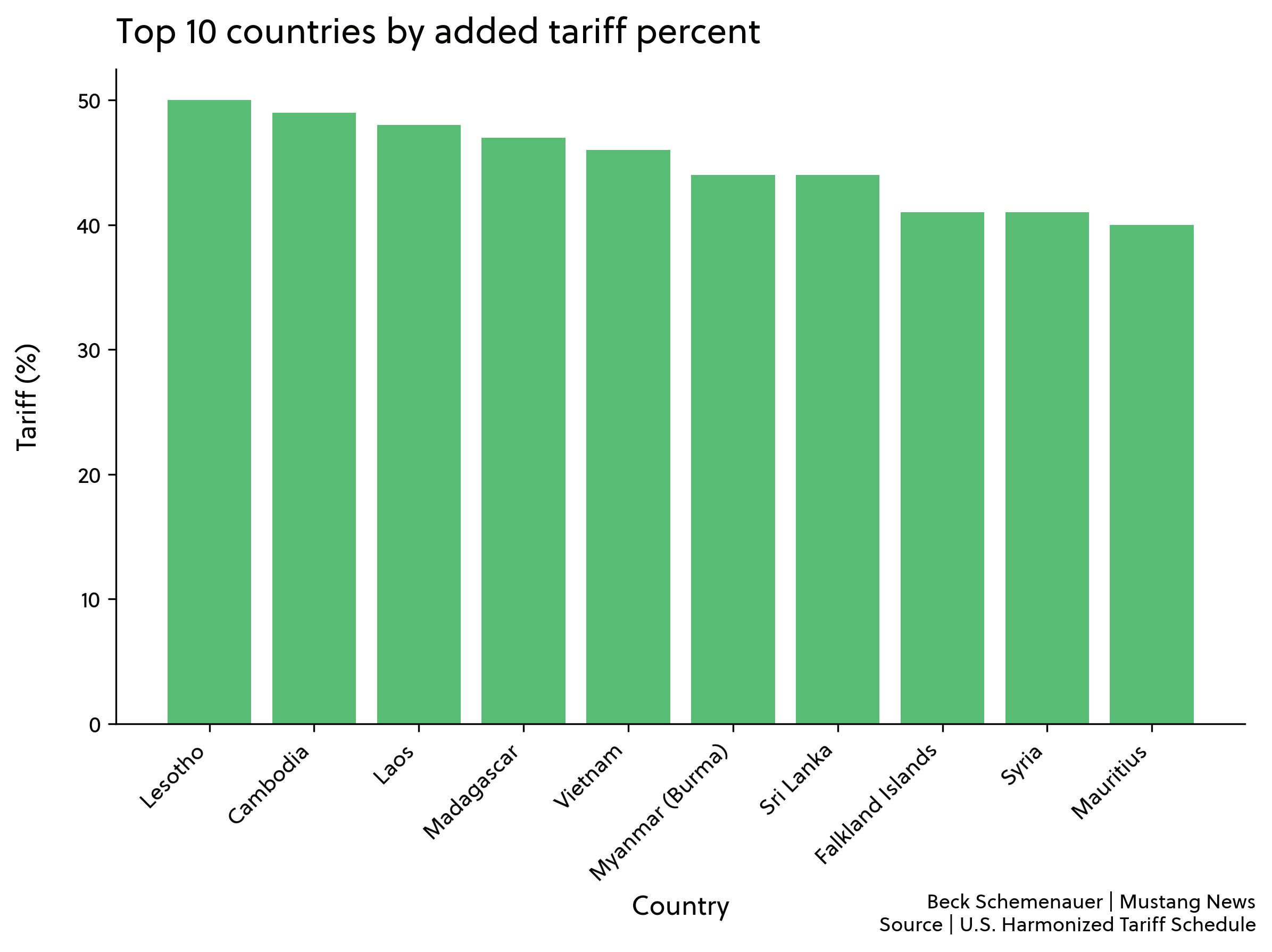
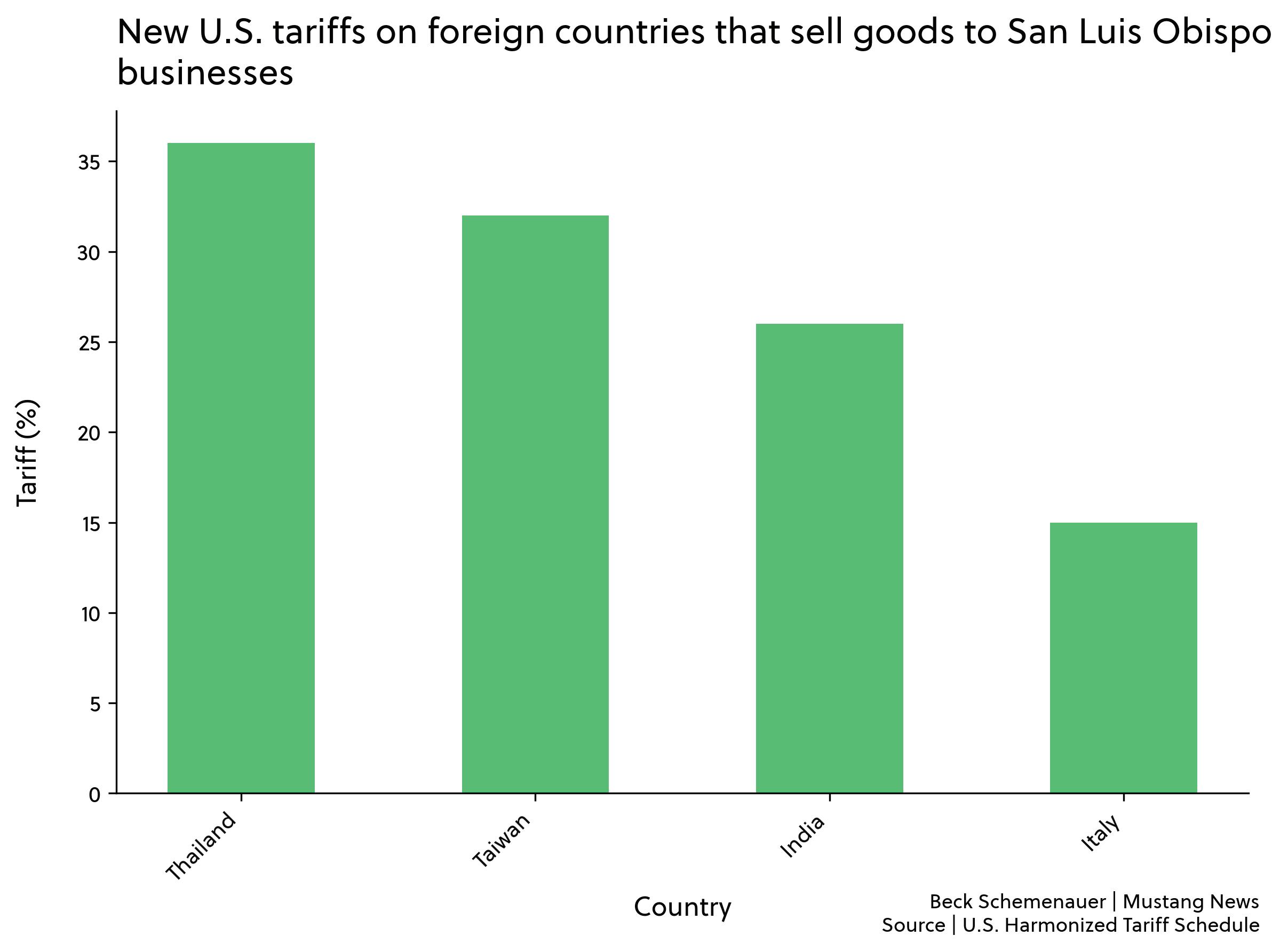
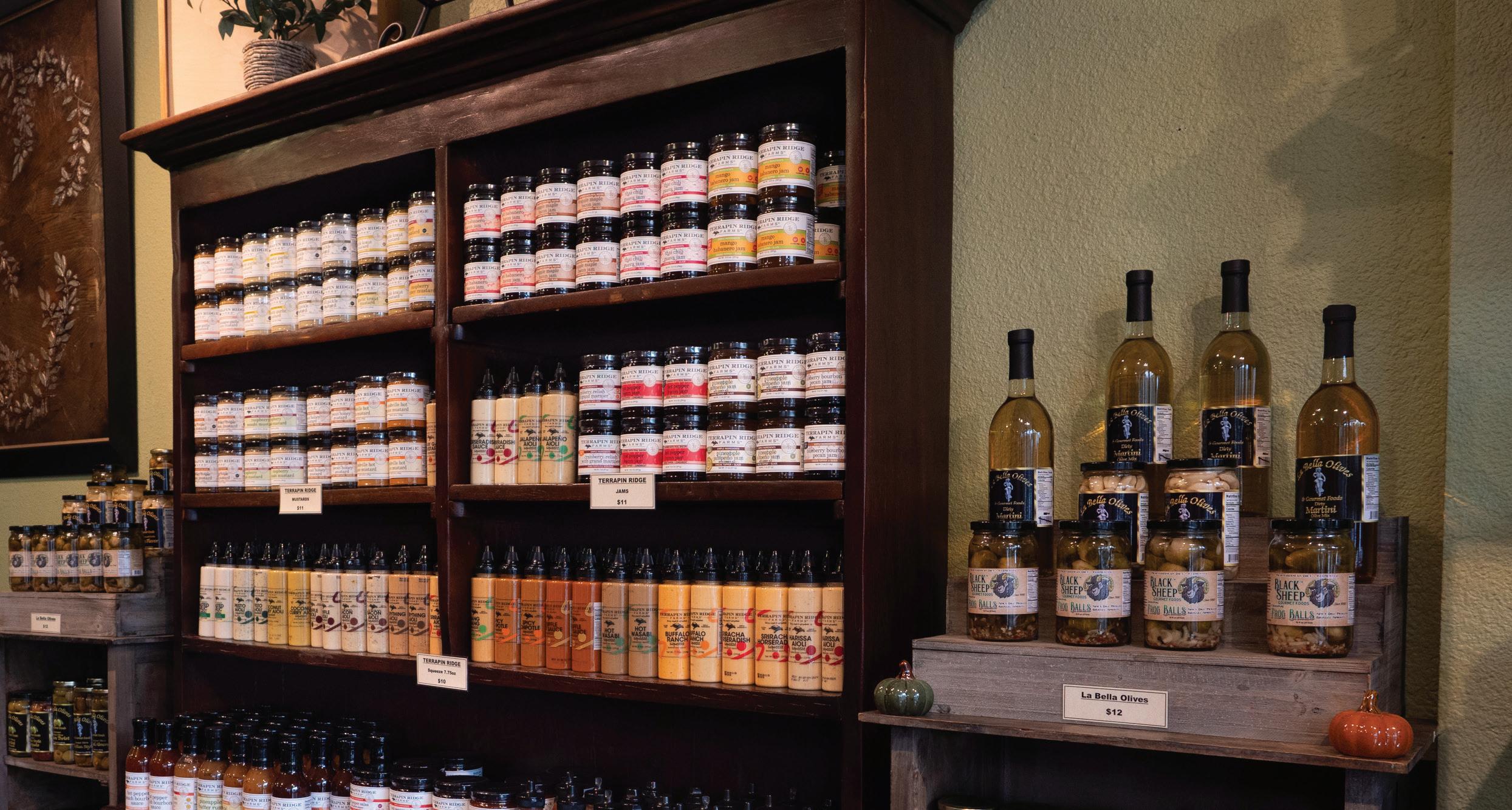
LÉA BOURGES-SEVENIER | MUSTANG NEWS
Two of the brands Central Coast Surfboards sells are produced in Thailand.
LÉA BOURGES-SEVENIER | MUSTANG NEWS SLO Olives sells products imported from Italy.
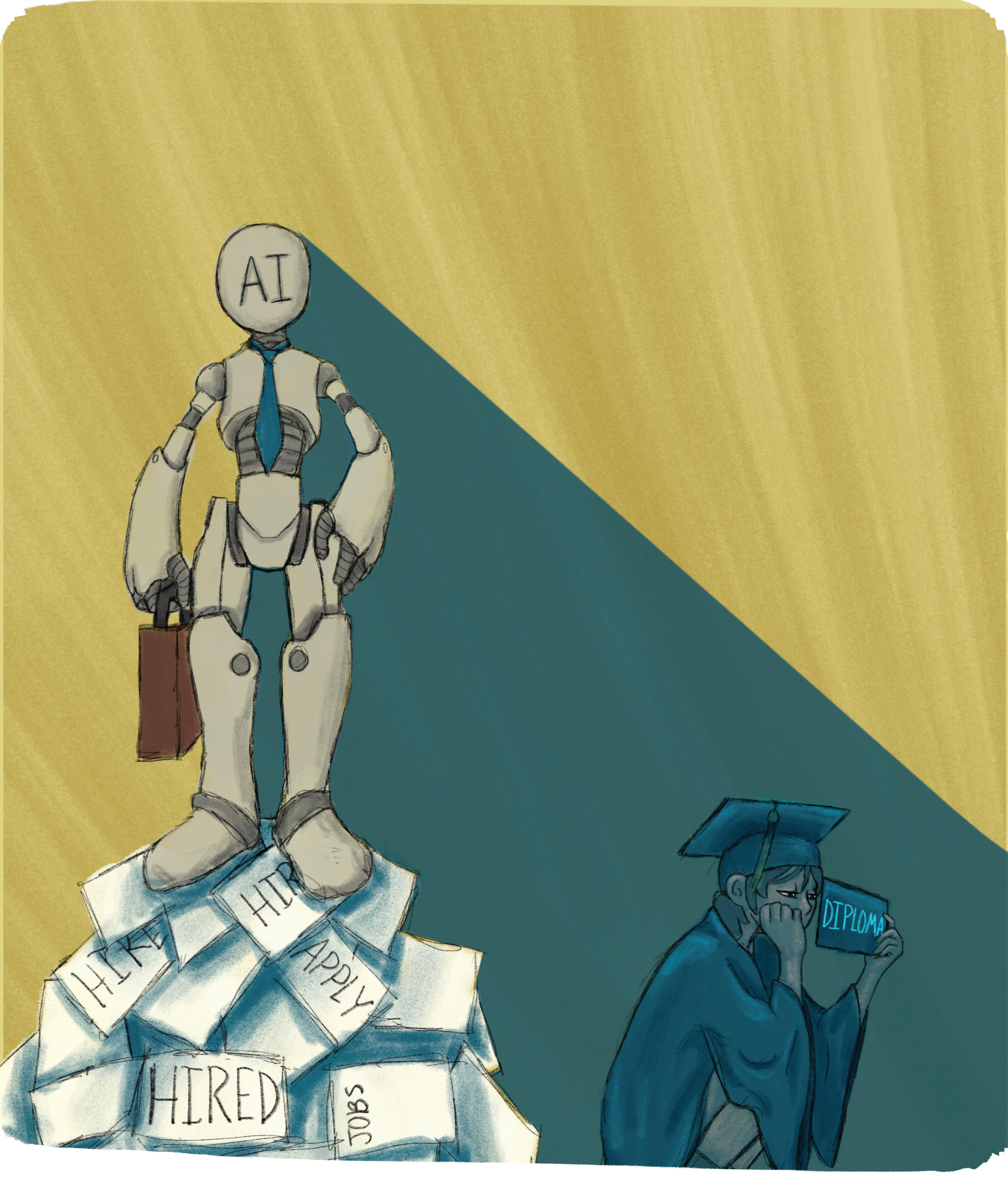
The Class of 2026 vs. AI
The Class of 2026 will graduate into a job market unlike any before it
STORY BY ALAN KO DESIGNED BY AVA CHEUNG
“I don’t feel sure that I’m gonna get a job by the time I graduate,” senior Nashali Vicente Lopez said.
Lopez is one of many students preparing to graduate without a clear answer on how Artificial Intelligence (AI) will affect her career. She started at Cal Poly as a computer science major to become a software engineer, but as AI tools advanced, she began to wonder if her future was being automated out from under her.
“AI made me question whether I was in the right major,” Lopez said. “It can already do the things I was trying to learn.”
Instead of switching majors, Lopez chose to study a concentration in privacy and security, a field she hopes will be less vulnerable to automation.
Lopez is one of more than 1,100 students enrolled in Cal Poly’s
Department of Computer Science and Software Engineering, a group entering the workforce at a time when the demand for traditional programming jobs is shrinking.
A Stanford Digital Economy Lab study found that employment for workers aged 22 to 25 in the most AI-exposed jobs, such as customer service and junior coding roles, has fallen by about 13% since 2022. That uncertainty stretches beyond Cal Poly. Across the country, students graduating in the Class of 2026 are preparing to enter a labor market that looks very different from the one they expected four years ago.
The average U.S. unemployment rate this year for degree holders ages 22 through 27 was 5.3%, considerably higher than the nation’s overall 2.7% jobless rate, according to the New York Federal Reserve.
Lopez hasn’t been able to land an internship, despite attending career fairs and applying to job openings.

Many companies at Cal Poly’s career fairs weren’t even looking for computer science majors, she said.
OBTAINING AN ENTRY-LEVEL JOB
Dr. Ryan Jenkins is a professor of philosophy at Cal Poly and the associate director of Ethics + Emerging Sciences Group. He researches how emerging technologies such as artificial intelligence shape human lives.
“The genie is out of the bottle,” Jenkins said. “We’re not going back to a world before we had these tools. Entry-level positions are often the lowest-hanging fruit for automation.”
“The
genie is out of the bottle. We’re not going back to a world before we had these tools.”
RYAN JENKINS Philosophy Professor
He added what makes this wave of advancement different is that it is targeting white-collar jobs, roles that typically require applicants to have a bachelor’s degree or higher.
“The question that every graduate will face is, why hire you instead of using AI?” Jenkins said. “Students need to prove what they can do that AI can’t.”
Without internships or clear entry points, several students worry they will be competing not just against other graduates, but against the very technology they’ve been told to master.
Lopez said that reality feels discouraging.
AI ON CAMPUS
Google Trends data for San Luis Obispo and Santa Barbara Counties shows a sharp spike in searches for ‘ChatGPT’ beginning in late 2022, with interest dipping annually during the summer and climbing again once classes resume in September.
Isla Vista and San Luis Obispo, both college towns, have significantly higher search interest than other municipalities in the region.
Lopez has used AI as a study tool, but worries employers may see it differently.
In a recent survey from the Digital Education Council, 86% of students said they use artificial intelligence in their studies.
“As a student, it’s embarrassing to admit you use ChatGPT,” she said. “But at the same time, I’ve learned

explain that to an employer.”
Students across the campus feel this uncertainty. Cal Poly’s Student Academic Integrity policy does not include an AI policy.
Professors are left to set their own rules that may differ from class to class. Some courses openly encourage the use of AI as a tool for brainstorming or coding assistance, while others prohibit it altogether.
Philosophy professor Patrick Lin, director of Cal Poly’s Ethics + Emerging Sciences Group, said his own assignments are designed to be “reasonably AI-proof,” while still offering the same educational value as traditional work. He also emphasized that any solution has to be sustainable for instructors, who are already overworked.
In spring 2025, Cal Poly announced students, faculty and staff would have access to ChatGPT Edu, OpenAI’s education-focused platform. The tool officially launched on April 28, already garnering 2149 unique active users by the end of April. The move followed a system-wide rollout across all Cal State campuses, giving students access to AI tools for writing, coding and research.
Cal Poly officials say the university is staying informed about how AI is reshaping the workplace.
“Cal Poly, and the ‘Learn by Doing’ education it provides, prepares students to be ready to make an impact in their career and their community from day one,” Keegan Koberl, university spokesperson, said.
Koberl said career counselors are following the latest research, trainings and employer feedback on AI, and Career Services regularly consults with its advisory council to hear directly from industry representatives.
On Oct. 21, Career Services will host a Computing and AI Career Fair at the Rec Center, giving students a chance to connect with employers in
cial intelligence.
BEING ‘READY DAY ONE’
A new Handshake report found that 61% of college seniors nationwide feel pessimistic about their careers. Almost half of them said their concerns are linked to AI.
For Lopez, those numbers feel familiar.
“The job market was already competitive,” Lopez said. “It’s becoming so tight that I’m worried about my future. Most people did get into CS because of software engineering, and now it seems like AI is going to be doing most of that job.”
Job postings that mention AI have jumped nearly five times since 2023, according to Handshake.
Most hiring managers now expect new hires to be comfortable using the technology, even as they fear it will make them replaceable.
“Employers are already expecting graduates to know how to use AI,” Jenkins said.
He added students must learn what their value is over AI in this evolving workspace.
The university’s ‘Learn by Doing’ model is based on practical and interactive experiences, but AI challenges what that experience should look like.
“We’re learning technical stuff starting day one,” Lopez said. “I don’t think it really prepares you for the job market. Sometimes you question: How is this assignment actually helping me? How is this useful in the real world?”
Being ready no longer means just mastering traditional skills. It also means knowing how to use AI effectively without letting it define your work.
“The risk is that the more hard work we turn over to AI, the more those things — empathy, ethical sensitivity, intellectual curiosity — are being corroded,” Jenkins said.
CAL POLY TPUSA'S TURNING POINT
After Charlie Kirk’s death, Cal Poly’s TPUSA chapter grows as students look to reshape its image
STORY BY ANGEL CORZO DESIGNED BY NATALIA CELEBRINI
Ryan Rundle began to pray and hope for the best after he had heard the news.
On Sept. 10, Rundle learned that Charlie Kirk, co-founder of the conservative nonprofit student group Turning Point USA, was shot in the neck at a Utah college campus on his American Comeback Tour.
Soon after, Kirk was confirmed dead by President Donald Trump due to his injuries.
Rundle, who now serves as the Cal Poly TPUSA chapter president and is a first-time official member of the club, said the club nearly doubled in size following Kirk’s death.
Over 100 students signed an interest form to join the conservative group before the start of the school year at the Week of Welcome (WOW) club showcase.
Despite not having a designated booth after failing to register on time, the university let TPUSA promote outside of the event.
“A lot of people joined after the assassination because I think they realized the importance of being able to, you know, unite together as a community,” Rundle said.
Following Kirk’s assassination, Rundle designated some responsibilities to himself as the leader of the university’s primary conservative hub for students.
For one, Rundle emphasized the importance of open conversation and discourse, resembling what he believes Kirk strived to do in his Prove Me Wrong tabling at Cal Poly in March 2024.
“If we don’t have these open conversations, what ends up happening is we drift farther from each other,” said Rundle, a business administration senior.
He also encouraged any student to join TPUSA at Cal Poly regardless of their background or beliefs and
“I’m gonna do my best for people that I even wholeheartedly disagree with on a fundamental principle to just be able to listen to them and where they come from and just have empathy.”
RYAN RUNDLE Cal Poly TPUSA President
wanted to include differing perspectives instead of creating an echo chamber of dialogue within the club.
“I’m gonna do my best for people that I even wholeheartedly disagree with on a fundamental principle to just be able to listen to them and where they come from and just have empathy,” Rundle said.
WHAT IS TURNING POINT USA?
TPUSA was founded in 2012 by Kirk, a conservative activist, with the intent to promote principles of limited government, free market and fiscal responsibility on college and high school campuses across the nation, according to the nonprofit’s website.
At the college level, there are over 800 TPUSA chapters scattered across the country.
Cal Poly’s TPUSA chapter was formally recognized as an active club in 2022, according to bylaw
documents for the group.
Since then, the club has hosted multiple speaker events on campus, including one in 2023 called “A Dad and a Detransitioner’s Take on the Transgender Movement,” which sparked a counter-protest outside of the Fisher Science building, Take Back Title IX featuring former collegiate swimmer and political activist Riley Gaines and, more recently, Charlie Kirk’s Prove Me Wrong on Dexter Lawn.
Ally Appel, the new club secretary for TPUSA at Cal Poly, said she admits the group has not been received well in the past by some students on campus.
She said people outside of the university’s WOW club showcase had referred to them as “Nazis” as they passed by.
The group had set up a makeshift spot outside of the WOW event, where they handed out flyers advertising the club’s plan to hold a vigil for Kirk.
Appel, a political science junior, said she and the other new members of the club have the opportunity to change student perception this year.
“Since we’re kind of revamping our group a little bit, it can maybe have an opportunity to be redefined in what people perceive us as,” Appel said.
Rundle said he attended the event with the detransitioned speaker held by the club in 2023 neither in support or protest but rather out of curiosity.
The event included political activists Chris Elston and Chloe Cole, who both spoke against transgender rights and “gender ideology,” Mustang News previously reported.
“I’ve had people respond harshly to me just because of even showing up and being willing to listen and have a conversation,” Rundle said in response to attending the event.
To Appel’s understanding, many on campus who perceive the group
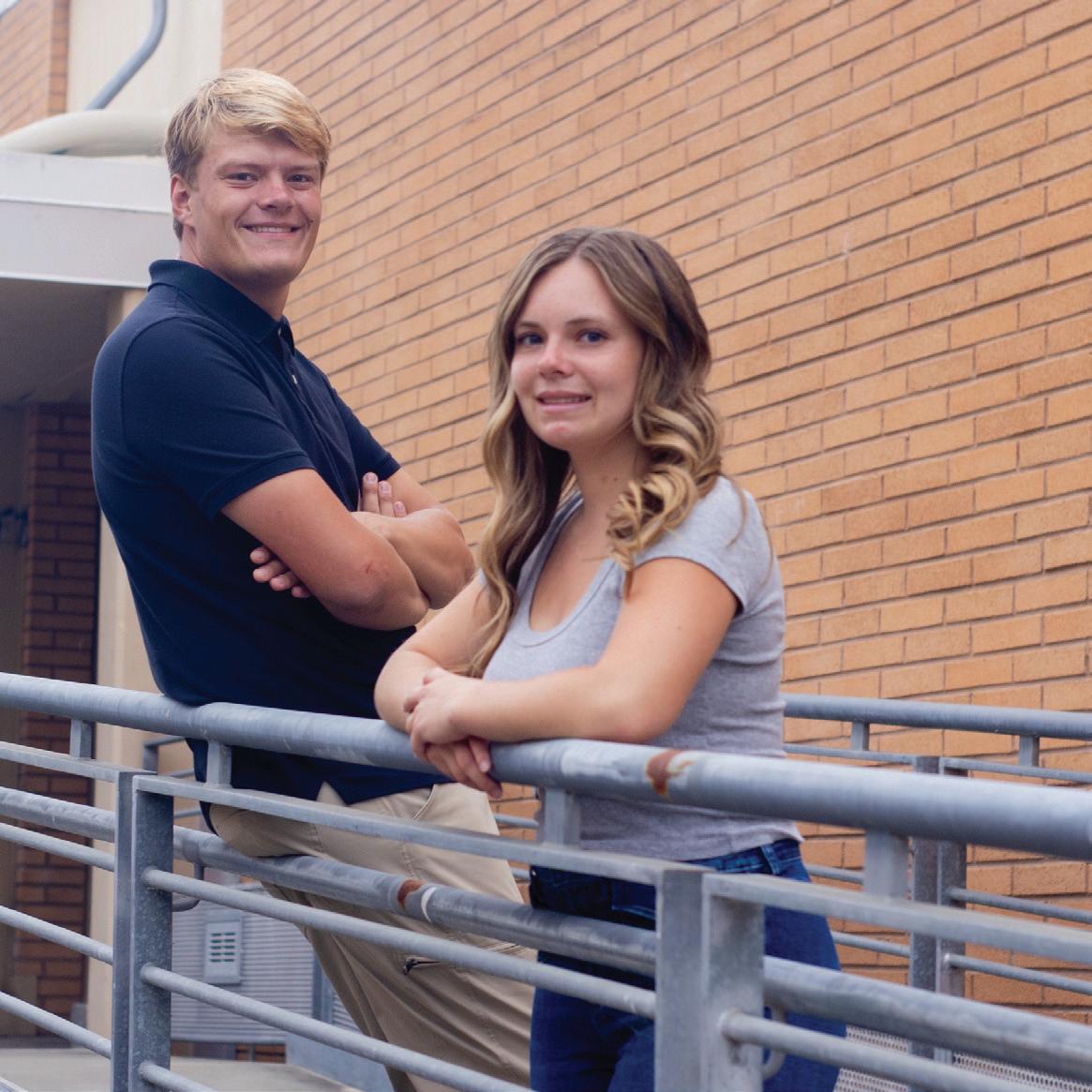
negatively are not “open-minded,” and she feels like most students have already established their opinions on TPUSA without giving the club a second thought.
KIRK’S INFLUENCE ON CONSERVATIVE YOUTH, DESPITE CONTROVERSY
Kirk’s role within the political arena for conservative youth rose around the same time as Trump’s first administration.
As an ally of Trump and an opponent of critical race theory, Kirk preached to crowds of mainly white conservative college students across the country.
Appel said she started following Kirk in 2020 through Youtube videos of him debating students. She said this was also around the same time she started developing her
political beliefs.
“I had a little addiction with like watching those type of videos,” she said.
The club’s secretary added that the exchange of ideas during Kirk’s college campus tours was something she didn’t see a lot in the media. Not only did Kirk influence many young conservatives who agreed with his view on racism, gun rights, abortion and transgender rights, but he also criticized those who opposed him.
After visiting Cal Poly, Kirk bolstered the attendance of conservatives at his debate at “one of the most liberal schools in the country” and called protesters “weak and pathetic.”
“San Luis Obispo is a very liberal town,” Kirk said on his podcast. “It’s like Seattle in California.”
BIA SOMMERS | MUSTANG NEWS
Ryan Rundle, TPUSA club president, and Ally Appel, club secretary, pose for a photo a week before their memorial event for the late Charlie Kirk.
NEWS OF KIRK’S DEATH SEEPS THROUGH CAL POLY
Rundle said he had met Kirk a few times, both on Cal Poly’s campus and at other TPUSA events, before the conservative activist’s death.
Although he only knew about Kirk after interacting with the club, Rundle felt hurt after hearing about the shooting and believed it was “something that could very well happen on our college campus.”
The club president said he was also disturbed by the videos that surfaced of Kirk’s death, calling it a “livestreamed” assassination.
Appel said she had a friend who was at Utah Valley University when Kirk was shot and notified her about what happened. Like Rundle, she too mourned the TPUSA founder’s death.
“I think he’s a good person,” Appel
said. “I really admired him. So it was just, it was just really upsetting.
At the university’s club showcase, Rundle told Mustang News he had been in communication with Cal Poly Police about safety measures for future events.
STATE OF FREE SPEECH IN THE COUNTRY
Comments about Kirk’s death have resulted in limitations to free speech nationwide, including latenight host Jimmy Kimmel, who had his show removed from air from Sept. 17 until Sept. 23 by ABC, as well as journalists and teachers who were fired for speaking out.
Rundle said he felt torn over the limitations of free speech in the country following Kirk’s death.
For one, Rundle said he does not agree with people who celebrate
BIA SOMMERS | MUSTANG NEWS
TPUSA club president Ryan Rundle, left, and secretary
Ally Appel pose near Dexter Lawn on Sept. 18. The club is revamping its presence on campus following the death of Turning Point USA founder Charlie Kirk.
“You shouldn’t be feeling threatened for speaking your voice.”
RYAN RUNDLE
Cal Poly TPUSA President
Kirk’s death, though he also does not agree with people getting fired from their jobs over their comments.
“You shouldn’t be feeling threatened for speaking your voice,”
Rundle said.
Rundle said he believes Kirk was
an example of free speech, discourse and leadership for college students but acknowledged the TPUSA founder had flaws.
“I don’t think Charlie Kirk was ever perfect, you know,” Rundle said. “I mean, no human is.”
THE FUTURE OF CAL POLY’S CONSERVATIVE GROUP
As the school year continues, Rundle said he is learning to navigate the TPUSA chapter at Cal Poly.
He said the club aims to continue protecting the right to free speech, and that TPUSA is “here to stay.”
The club president also encourages people to join the club regardless of what they believe in, and hopes to bring more guest speakers to campus as well as promote other activities for members.
“You’ll probably find some people
you agree with, some people you disagree with,” Rundle said. “And you know, that’s kind of the point.”
“You’ll probably find some people you agree with, some people you disagree with,” Rundle said.
“And
you know, that’s kind of the point.”
RYAN RUNDLE
Cal Poly TPUSA President




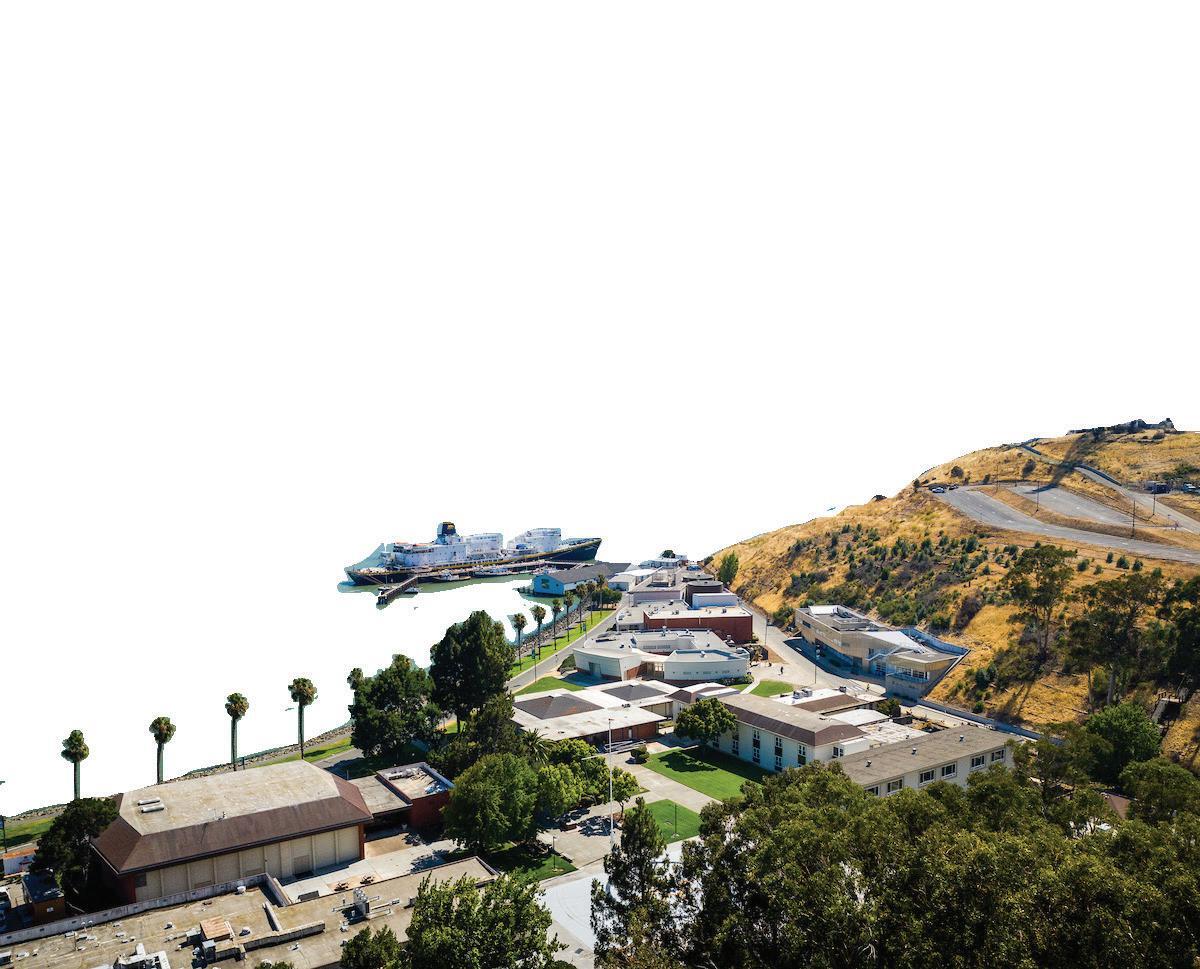
STORY BY NISHITA MUKHERJEE
DESIGNED BY MAYA SHINDEN
Four hours north of San Luis Obispo lies Cal Poly’s newest addition, Cal Poly Maritime Academy. As of July 1, the universities merged their administrations into one, and exactly one year later, they will academically merge into one university. Following the merger, a shift in leadership and student culture is already underway. The merge was primarily executed to financially stabilize the Maritime campus funds, bringing in approximately $35 million over the next seven years. It was a match academically, since both universities are known for their niche majors and hands-on experiences. The merger will also help provide the Maritime campus with more national recognition.
Cal Poly Maritime Academy, formerly known as Cal Maritime, was founded in 1929 and joined the Cal State system in 1995. The campus is one of seven degree-granting maritime academies in the United States. These are schools that specify studies around maritime training throughout the country. Cal Poly Maritime Academy is the only one along the West Coast.
Since the 2016-17 academic

year, Cal Maritime shed 31% of its students, with enrollment dropping from 1,107 students to 804 last fall, according to Cal State data.
The Maritime Academy has set up their classes and hands-on curriculum to prepare their students for jobs working at sea straight out of school, according to Eric Jones, the campus’s new superintendent. Many of their programs and tech resources on campus are meant to give students industry experience, heavily falling in line with Cal Poly’s ‘Learn by Doing’ philosophy.
Maritime students will typically start work days early in the morning and go until 10 p.m., with classes built around hands-on learning and application based projects, according to Tyler Venator, mechanical engineering senior and Commander of the Core Cadets.
“It’s a great time with your friends, but you also have a great time learning. I don’t think there’s anything like it,” Venator said.
Even in a work-first environment, the cadets are able to find joy and bond from spending time on the ship together.
“Inclusivity is a big thing that we’re trying to work on,” Venator said. “Not just because we want to get more workers in the industry, of course we have a mariners shortage, but
because I believe this is such a great industry you can learn from personally and professionally.”
“My father went here and my grandfather before him, so I was instilled a little bit of pride about this school before I even came here. As things change and as things develop and grow, I think it’s been quite nice to see the school become what it is today and what it can be in the future.”
TYLER VENATOR
Mechanical Engineering Senior and Commander of the Core Cadets
There has been a consistent deficit of mariners to meet United States shipping needs for years, according to the Department of Transportation.
“My father went here and my grandfather before him, so I was instilled a little bit of pride about this school before I even came here,” Venator said. “As things change and as things develop and grow, I think it’s been quite nice to see the school become what it is today and what it can be in the future.”
MARITIME TRADITIONS
International business and logistics sophomore Kate McGowan has enjoyed her experience at Maritime Academy. She is currently the president of the propeller club and a resident advisor.
“I’ve just had a lot of hands-on experience as a business major here,” McGowan said. “It’s a big community and everyone knows everyone here. It’s nice to have a huge network.”
After graduating, she hopes to go into maritime brokerage or contracting in the industry.
“I felt like I immediately belonged here and in the maritime industry,” McGowan said “It’s a rough industry but it loves the people that are a part of it.”
As a part of the culture on campus,
some of the popular clubs include aquarium odyssey club, propeller club and collegiate wind club according to international business and logistics senior and former President of the Associated Students Nikhil Hunter.
Hunter also enjoys traditions such as “The Clap.” The tradition is a round of applause within the dining hall whenever a dish accidentally drops on the floor. Since the dining hall at the academy is relatively small, any fall or drop is echoed and heard throughout the entire building.
The academy offers a summer term at sea where cadets are able to apply their training directly on the training ship while at sea.
“Our deck cadets do something called celestial navigation,” Venator said. “For the 65 days they are sailing, they need to track the stars and figure out their positions. I can say it’s stressful.”
The Sinbad Games, a longstanding Maritime Academy tradition, takes place on the ship during summer sea term. Venator describes the Sinbad Games as the “Olympics on water,” where students dress up and compete in a series of obstacles. The winner is able to disembark the ship first at the end of the term.
Typical training includes opportunities such as the full-mission bridge
CAL POLY MEDIA | MUSTANG NEWS
Cal Poly Maritime Academy campus aeriel view.
simulator, also known as the ‘sea sickness simulator,’ which replicates the experience of different boats in varying locations. It costs around $1 million and needs $100,000 mainte nance annually, according to Marine Transportation Department Chair Elizabeth McNie.

UNDERGRAD MAJORS
“I
felt like I immediately belonged here and in the maritime industry, It’s a rough industry but it loves the people that are a part of it.”
MINORS GRAD PROGRAMS

KATE MCGOWAN
International Business and Logistics Sophomore
ership will include the new CEO and Vice President Corey Cook. He previously served as vice president and provost at St. Mary’s College of California and also was the founding dean of the School of Public Service at Boise State University.
Jones, the new superintendent, will oversee the academy’s hands-on programs and is backed by 35 years of service in the U.S. Coast Guard, where he oversaw 57,000 members and coordinated multiple emergency responses during Hurricanes Irma, Dorian and Maria.
With the new funding and expansion of the Maritime Academy, the university has been able to add to their total number of programs. One new project includes the construction of a pier on campus, meant for a new multi-mission ship named the Golden State, arriving in the fall of 2027.
According to Jones, the new ship will be longer and tonnage-wise larger than their current training ship allowing it to carry 600 students, double the previous amount.
The Golden State will contain a command center with a separate communication network which



CAL POLY MEDIA | MUSTANG NEWS
A cadet works in the engine room on Training Ship Golden Bear (TSGB).
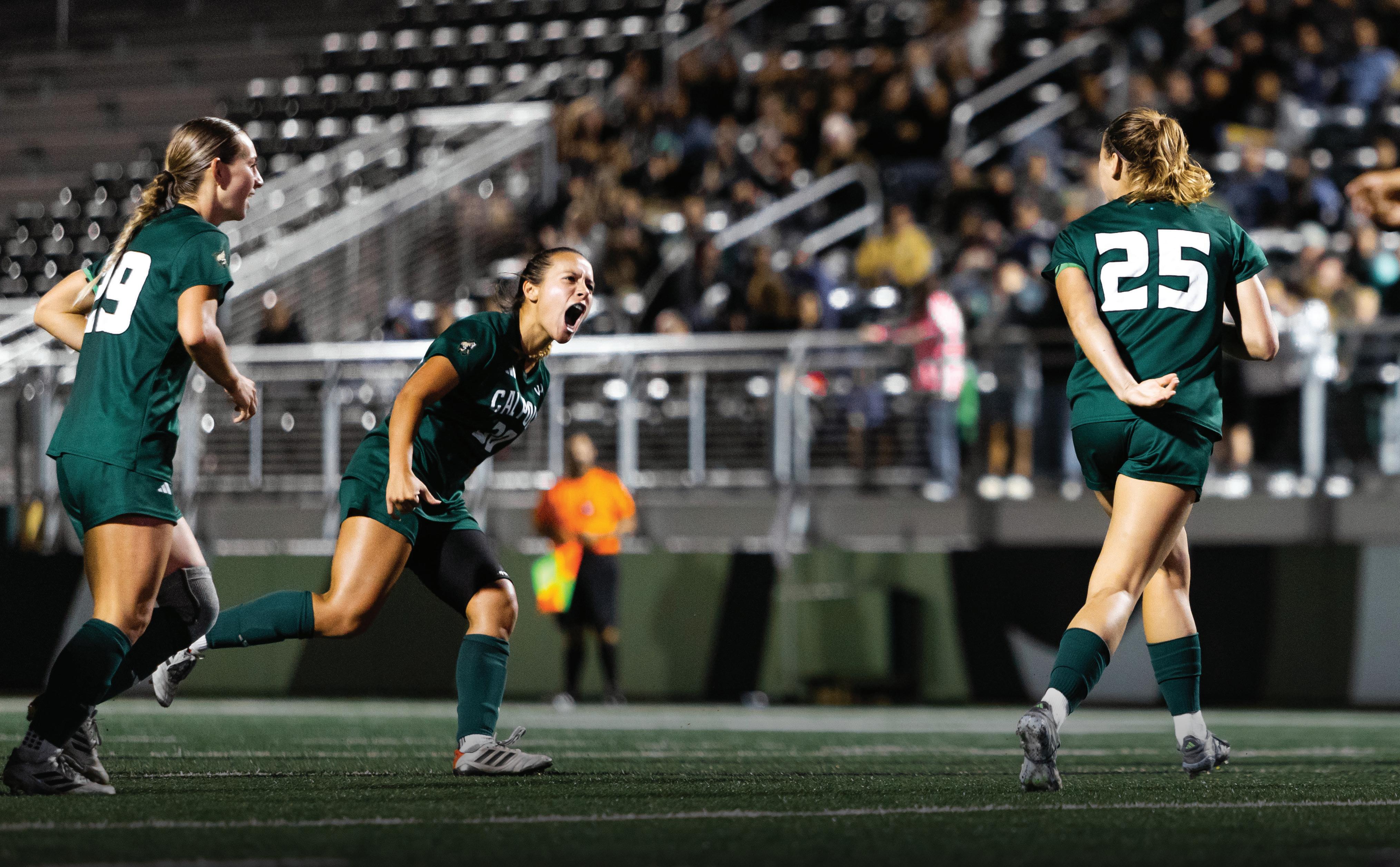
The words of wisdom behind Cal Poly Women’s Soccer’s historic start
STORY BY ANDREW AGUINIGA
DESIGNED BY ELENA VAUGHAN
Cal Poly Women’s Soccer opened the 2025 season with nine non-conference matches and escaped the slate unbeaten, becoming the first team in program history to do so. The Mustangs went 2-0-7 in that span, breaking the program’s record of most ties achieved in a single season.
The unbeaten stretch was also the team’s longest overall since opening the 2005 season with a 6-0-3 record. Last season, they had one win in their first nine games.
Newly appointed head coach Bernardo Silva says G.R.I.T. got the team to one of the program’s best starts. The acronym has a double meaning: it can be interpreted through the literal definition of the word “grit” or each letter of the abbreviation can be used to reflect his core principles.
“G” stands for grind. The “R” is for respect. “I” initializes integrity. And the “T” represents a
team-first mentality.
Silva was quick to embed the G.R.I.T. philosophy into the team’s culture, and it is only one of a slew of slogans he implemented into the culture. The philosophy and mindset shift have yielded results that have been nothing short of historic.
With Silva’s mottos in mind, the Mustangs have inserted themselves as a Big West contender, having landed in a three-way tie for fourth place in the conference. They were one of only 18 teams across the nation to remain undefeated before falling to UC Santa Barbara in the conference-play opener on Sept. 18.
As of Oct. 7, their record is 4-1-8.
CAL POLY 2.0
Silva originally served as Cal Poly’s assistant coach from 2013–16 and left for other coaching opportunities at UC Santa Barbara, Sacramento State and Cal State Bakersfield.
Despite leaving Cal Poly, Silva continued to identify with the Mustangs and held a persistent
belief that he would return to the university.
“It’s always been this dream job for me, so I felt like I was coming home,” Silva said. “I think this is one of the best jobs in the West Coast. I love Cal Poly. I love what Cal Poly is all about.”
With Silva as only the second man at the helm in program history, a new age has been ushered in for the Mustangs.
With the new era officially being dubbed “Cal Poly 2.0,” by Silva, the Mustangs aim to honor the foundation laid out by former head coach Alex Crozier while also distinguishing themselves from the prior era.
Cal Poly 2.0 is characterized by a hard-working and gritty team identity, all of which can be captured in another one of Silva’s many mottos.
“The standard is the standard,” Silva often says to the players.
The phrase was curated by Silva and the team’s three captains in an offseason meeting, serving as a consistent reminder of the all-in mindset the team has adopted as their own. The expression is utilized
Gritty people tend to be more successful sustainably than just talented people.
BERNARDO SILVA Women’s Soccer Head Coach
to keep the players accountable, to ensure that anything less than maximum effort is not tolerated.
“I think it speaks well to our team,” senior forward and captain Jessie Halladay said. “You play as best as you can for the team and there’s no excuses because we’re all giving 100%. We do that for each other, regardless of the circumstances.”
The motto and its significance to Silva is reflected in his coaching style as well. Upon being hired, he immediately put effort into cultivating a team culture that is defined by selflessness and hard work.
The Mustangs continuously stress the importance of making and maintaining close, personal relationships with one another. Forming close bonds with other teammates and staff is a staple of Silva’s and the Cal Poly program’s culture as a whole, and the players have embraced the interpersonal mindset.
“We have this saying that goes ‘it’s all about the person next to us’ and I think that’s super prevalent in our culture,” senior midfielder and captain Sophia Minnite said. “It’s so important, from both a soccer and
Sophia Minnite, Camryn Penn, and Jessie Halladay celebrate Halladay’s goal.

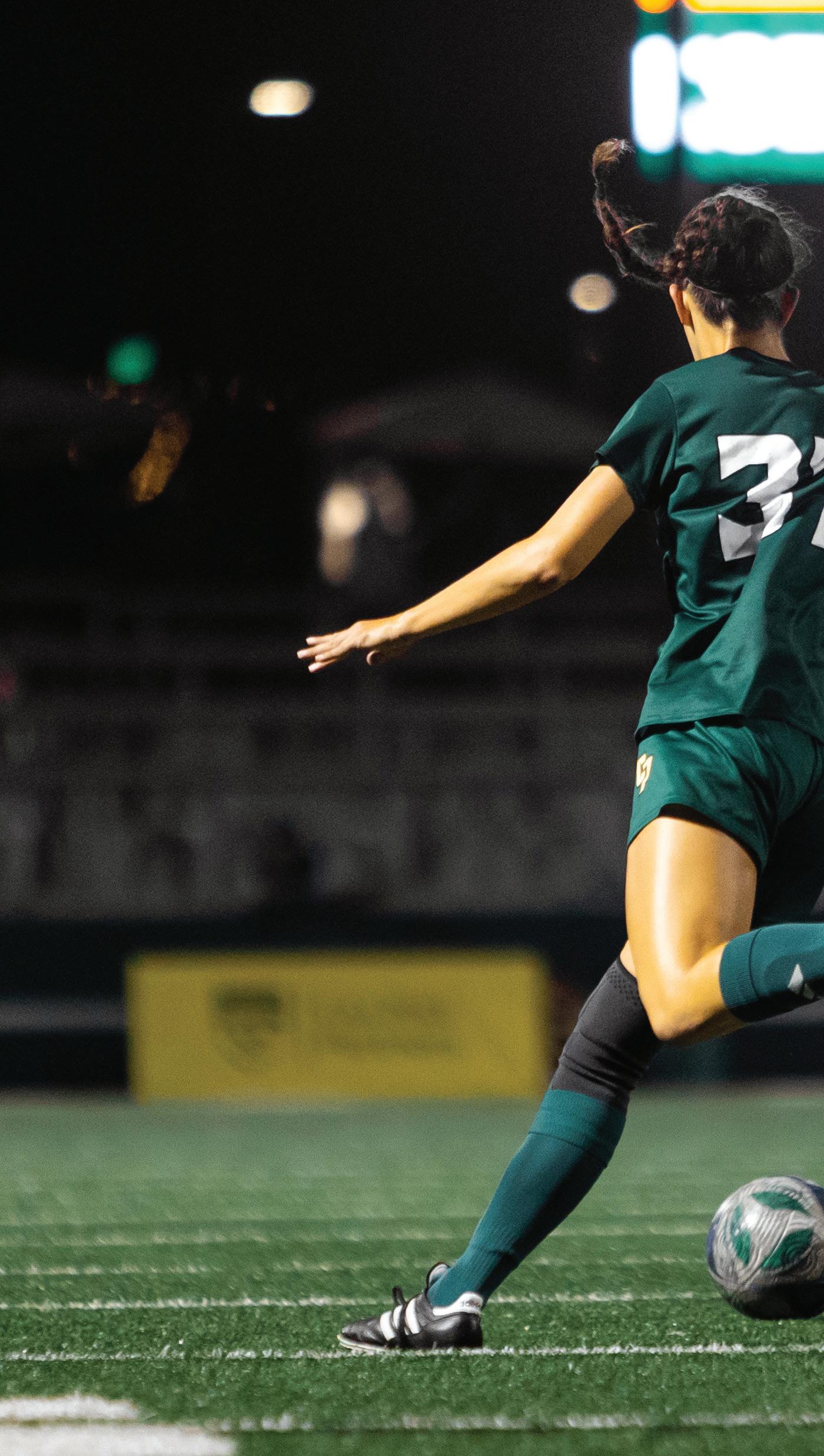

life standpoint, to build those friendships and relationships that will last a long time.”
In the offseason, Silva established an emphasis on the significance of both individual and team fitness overall. Silva added several drills targeting the team’s endurance. The fast-paced, intense practices have seemingly paid off, allowing the Mustangs to stay alive late in the game and maintain control over how the game is played rather than being forced to adapt to how the game develops.
This is further demonstrated in the timing of the team’s offensive successes. Of the 17 goals Cal Poly has netted across the season thus far, nine of them have come in the second half of the match.
“We’re definitely a lot more fit and able to press our opponents the way we want to and able to maintain possession of the ball within the game as much as possible,” senior defender and captain Camryn Penn said. “Being able to do all that and not get as tired as we used to helps us make sure that we can dominate our games as much as possible.”
The standard is all about not allowing external factors to control it and I think that’s the story of our season so far. It’s what the story of our season will be.
BERNARDO SILVA Women’s Soccer Head Coach
GRITTINESS TO SUCCESS, A PIPELINE
Each part of Silva’s coaching philosophy boils down to one mindset: grit brings success. It is a lesson he picked up when coaching the Bakersfield women’s soccer program.
“Gritty people tend to be more successful sustainably than just talented people,” Silva said. “Bakersfield is gritty, a city that’s an underdog. I leaned into that underdog identity and brought a piece of it to Cal Poly.”
The gritty, aggressive playing style has allowed the Mustangs’ offense to thrive as they have crafted one of the most impressive attacks in the Big West conference.
As of Oct. 7, Cal Poly has tacked on 22 goals in their 13 total games played, the most scored in the conference.
This is a direct contrast to the season prior in which the Mustangs netted only 15 goals in their first 13 games, five of which had come from a single game — a win
against Nevada.
Cal Poly’s 2025 squad have scored at least one goal in 11 of their first 13 matches played, whereas the 2024 Mustangs scored at least once in only seven of their first 13 games.
Halladay is the highlight of the high-octane offense, accounting for seven of the 22 goals. She leads the Big West conference in goals scored by an individual player.
Junior Annika Smith follows close behind with five goals, tied for second in the conference.
Overall offensive opportunities are not lacking as well; the Mustangs hold an eight-shot lead over rival UCSB for the most shots taken in the conference. Halladay has also fired the most shots in the conference among individual players.
The Mustangs’ gritty playstyle requires an elevated level of communication and positive team chemistry in order to work effectively in-match.
In addition to fashioning an intense, competitive atmosphere to fuel Cal Poly’s approach, Silva also prioritized creating a positive,
relationship-oriented team culture that the players have deemed “a sisterhood.”
“We’re a pretty strong sisterhood because we care about each other so much on and off the field,” Minnite said. “We just enjoy being around each other and I think that’s what makes us want to work for each other.”
With an entirely new mindset and way of play having been fully established in the non-conference slate, the Mustangs set their sights on their first Big West matches under the Cal Poly 2.0 program.
Cal Poly is preparing for the Big West by practicing consistency and internal focus, using it as their guiding light to find success within the season.
“We just prepare for every game like it’s a battle, so it’s just bridging consistency,” Silva said. “The standard is all about not allowing external factors to control it and I think that’s the story of our season so far. It’s what the story of our season will be.”
CHLOE BRIOTE-JOHNSON | MUSTANG NEWS
Emily Lieber in action.
CHLOE BRIOTE | MUSTANG NEWS
The team celebrates after Halladay’s goal.
Carter Henderson will start as Cal Poly’s Athletic Director on Oct.13
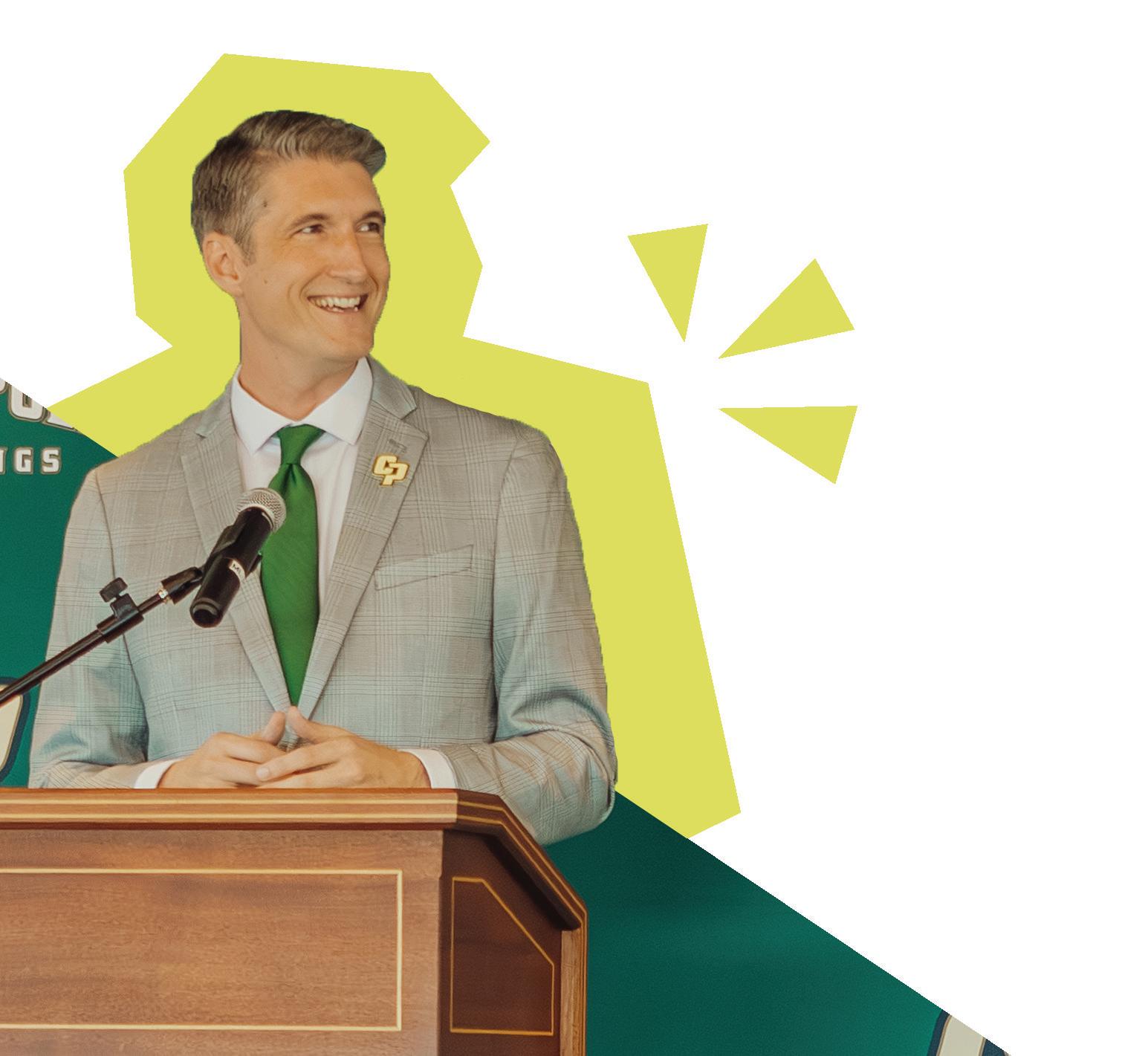
Henderson comes from Stanford, where he served as deputy athletics director
CHLOE BRIOTE-JOHNSON | MUSTANG NEWS
Carter Henderson speaks at the new Athletic Director announcement on Sept. 25.

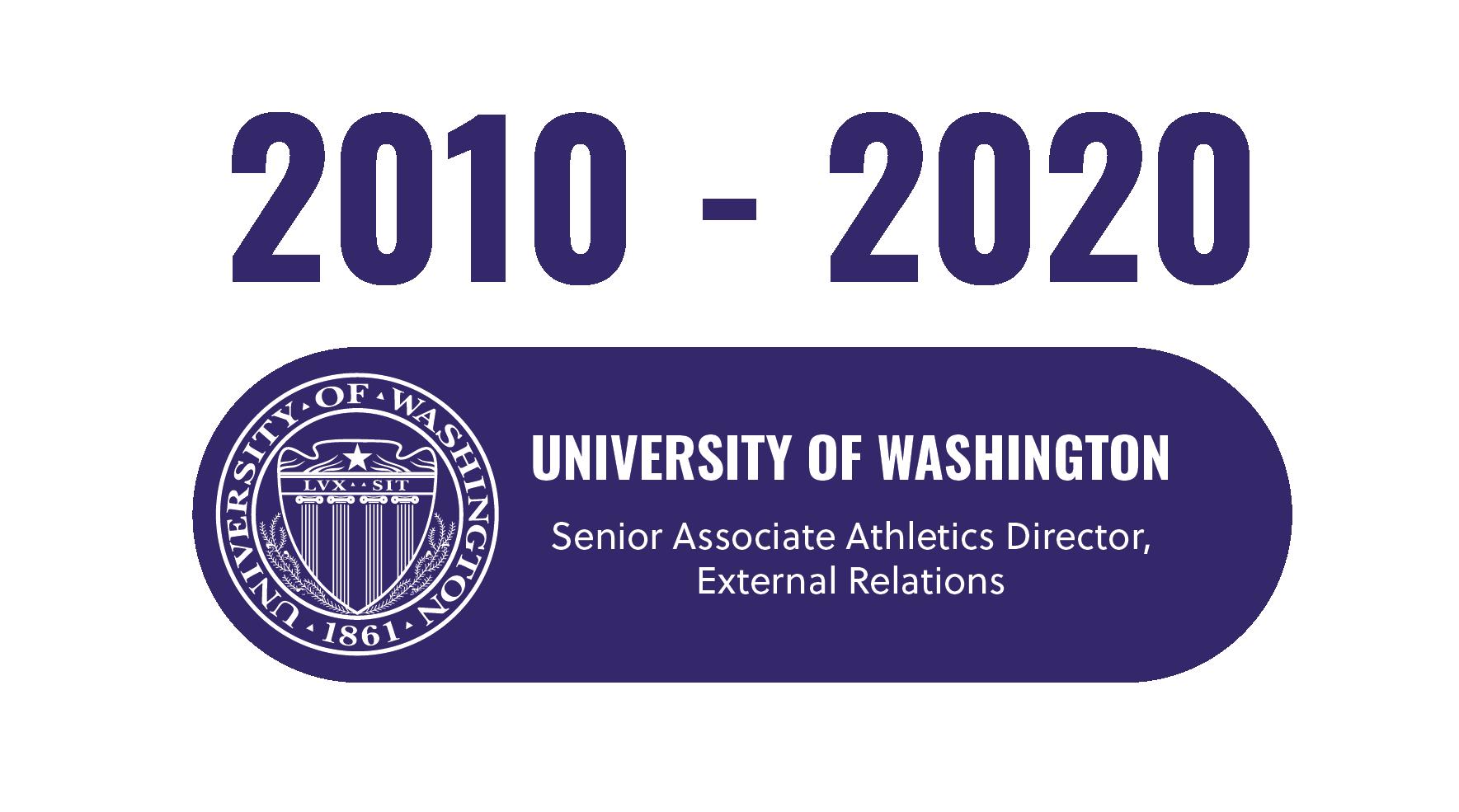
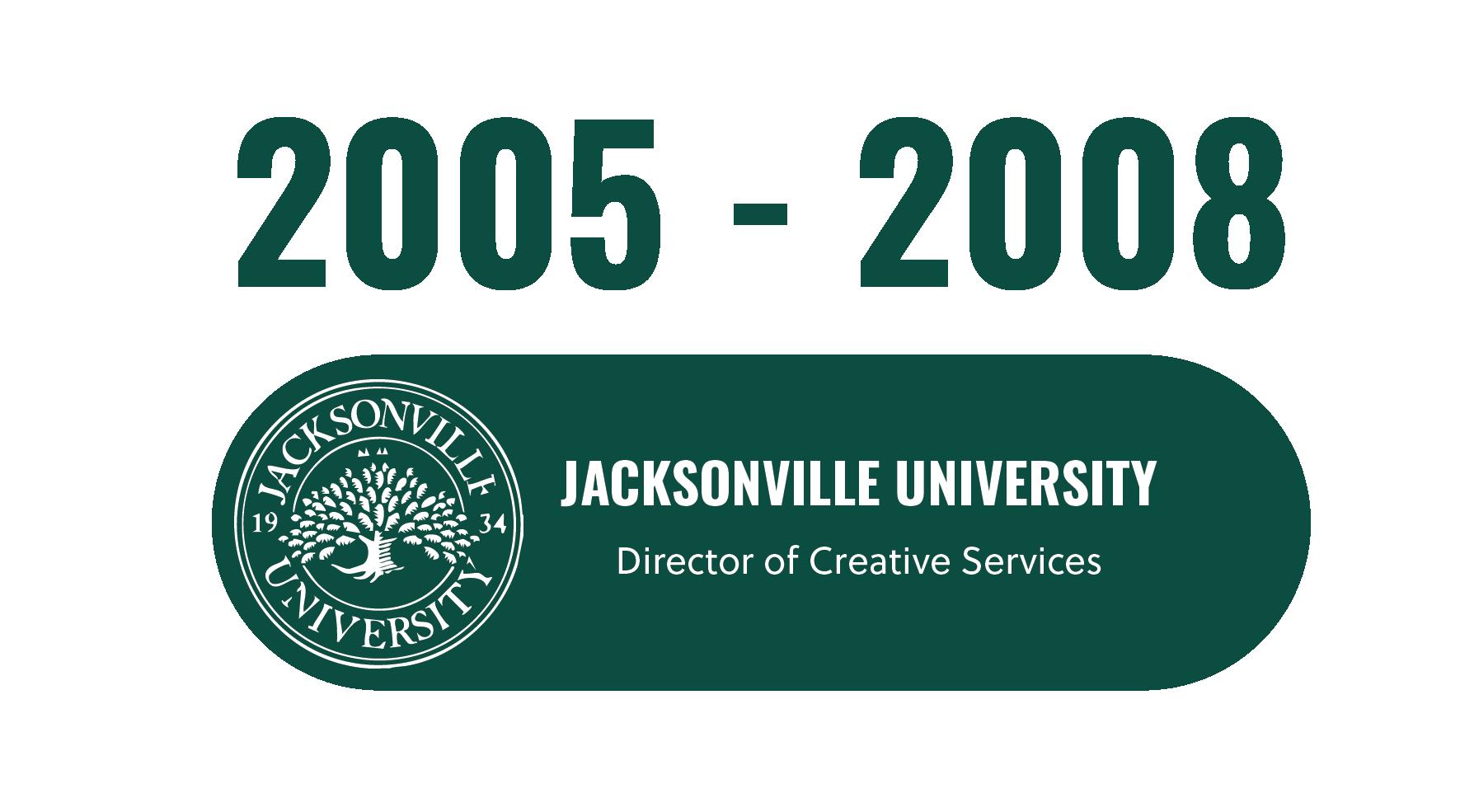
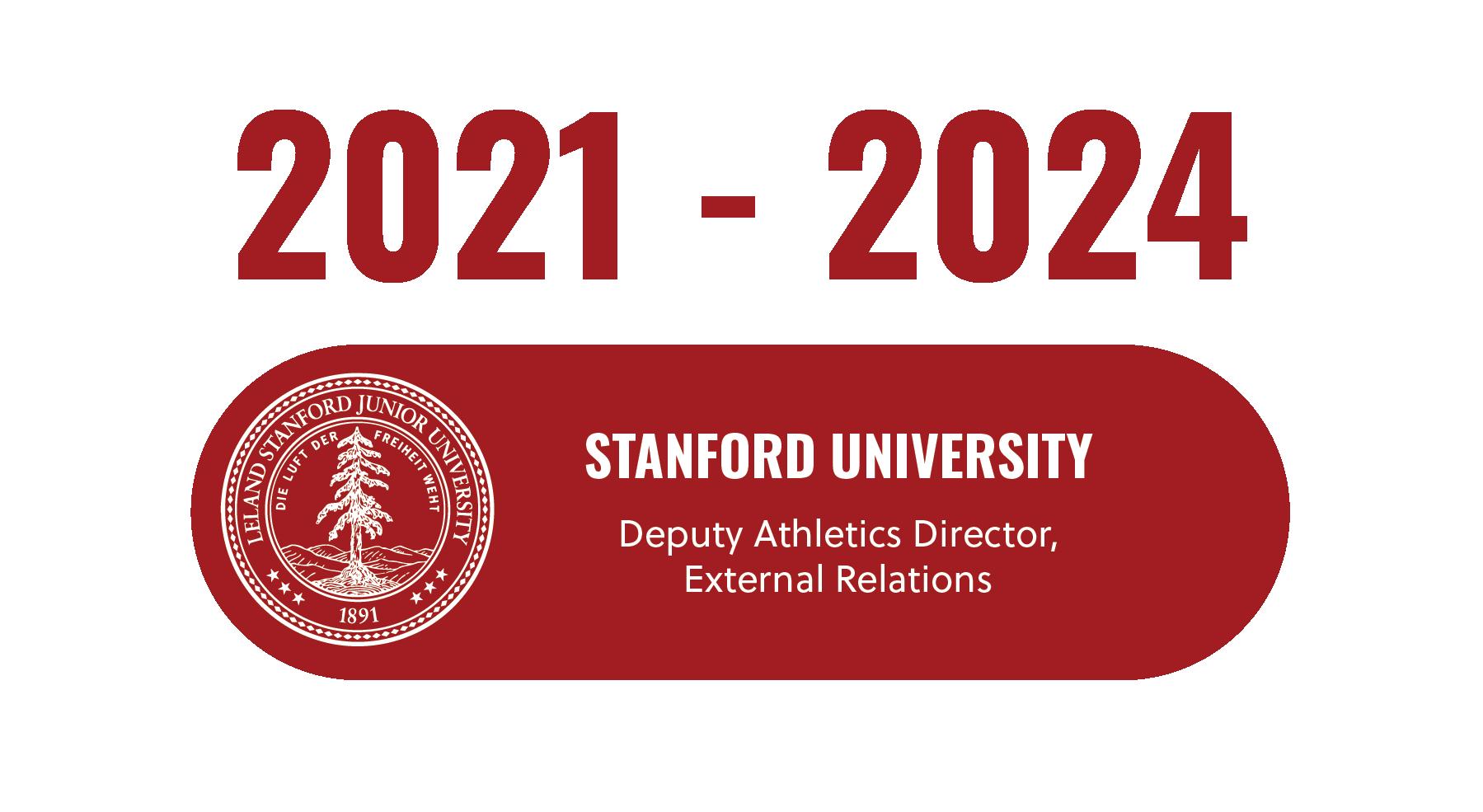
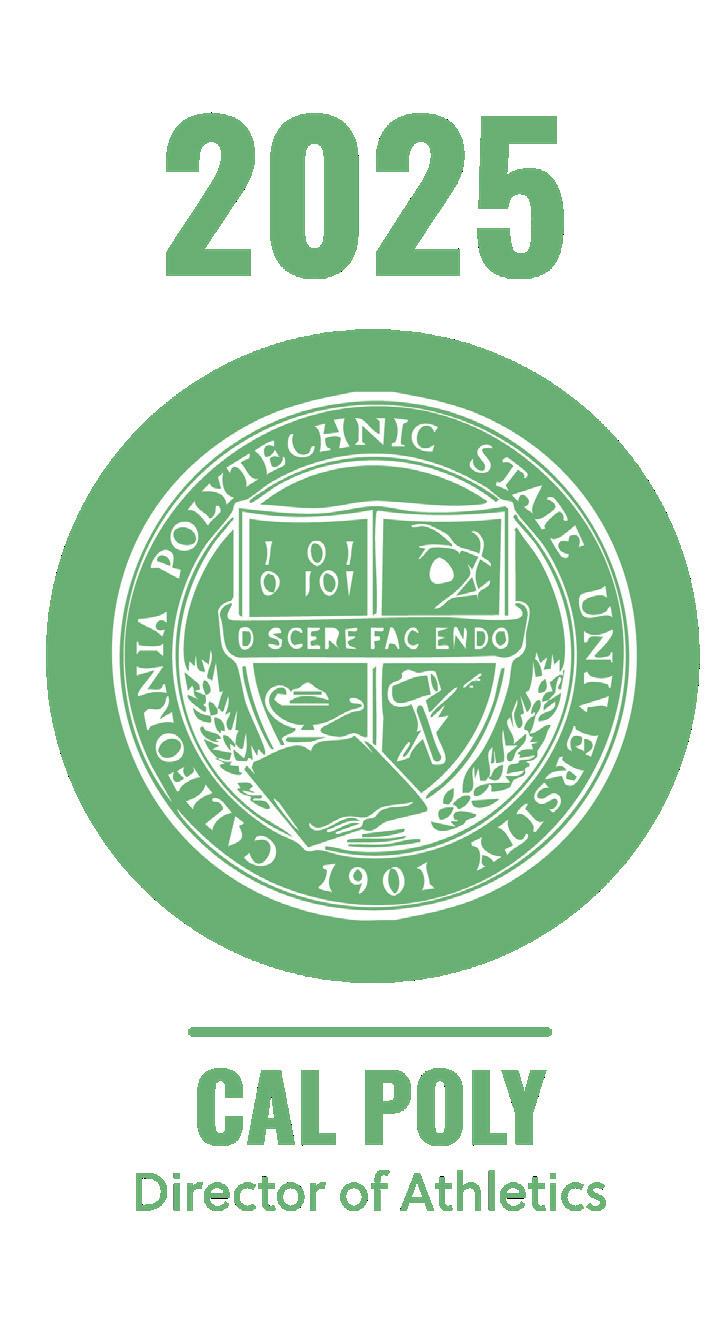
STORY BY LILIA MCCANN
DESIGNED BY ANIKA LOGANATHAN
This story was originally published to mustangnews.net on the day of the announcement, Sept. 25.
Carter Henderson was selected as the new Cal Poly Director of Athletics, replacing previous athletic director Don Oberhelman after 15 years in the position. He will officially take over the position on Oct. 13. Henderson served as the deputy athletics director at Stanford University beginning in June 2024, and was previously part of their communications and athletics departments for nearly five years.
“Carter is committed to making Cal Poly Athletics better every single day, encouraging those around him to be a little faster, a little stronger and a little smarter,” Cal Poly President
Carter is committed to making Cal Poly Athletics better every single day, encouraging those around him to be a little faster, a little stronger and a little smarter.
JEFFREY ARMSTRONG Cal Poly President
Jeffrey Armstrong said at the press conference on September 25th.
Before his time at Stanford, Henderson spent over 10 years in the communications department at the University of Washington and before that, four years at Jacksonville University as the Director of Creative Services.
In his remarks at the press conference, Henderson emphasized his desire to balance competitive success alongside academics and community support.
“We will look at community, we will look at the classroom and we will look at competition,” Henderson said. “If we’re not competitive from a conference perspective and chasing national championships, we’re doing a disservice to all of our supporters and our student athletes in our program.”
Oberhelman announced his retirement last June, beginning a national search for his replacement.
If we’re not competitive from a conference perspective and chasing national championships, we’re doing a disservice to all of our supporters and our student athletes in our program.
CARTER HENDERSON Cal Poly’s Athletic Director
He continued to serve in his role throughout the process, despite the original announcement that the new athletic director would be appointed by the end of the summer.
In the past year, Cal Poly increased efforts surrounding athlete compensation, including the decision to opt into the NCAA v. House settlement and to establish the Cal Poly’s Players Trust.
Oberhelman faced controversy following the decision to discontinue the swimming and diving program in March and elevate STUNT to varsity sport status, sparking widespread conversation about department funding and the future of non-revenue sports.
Henderson inherited Cal Poly Athletics at a tumultuous time in college sports, with the responsibility to foster athlete excellence and academic success for the program through a rapidly changing landscape.
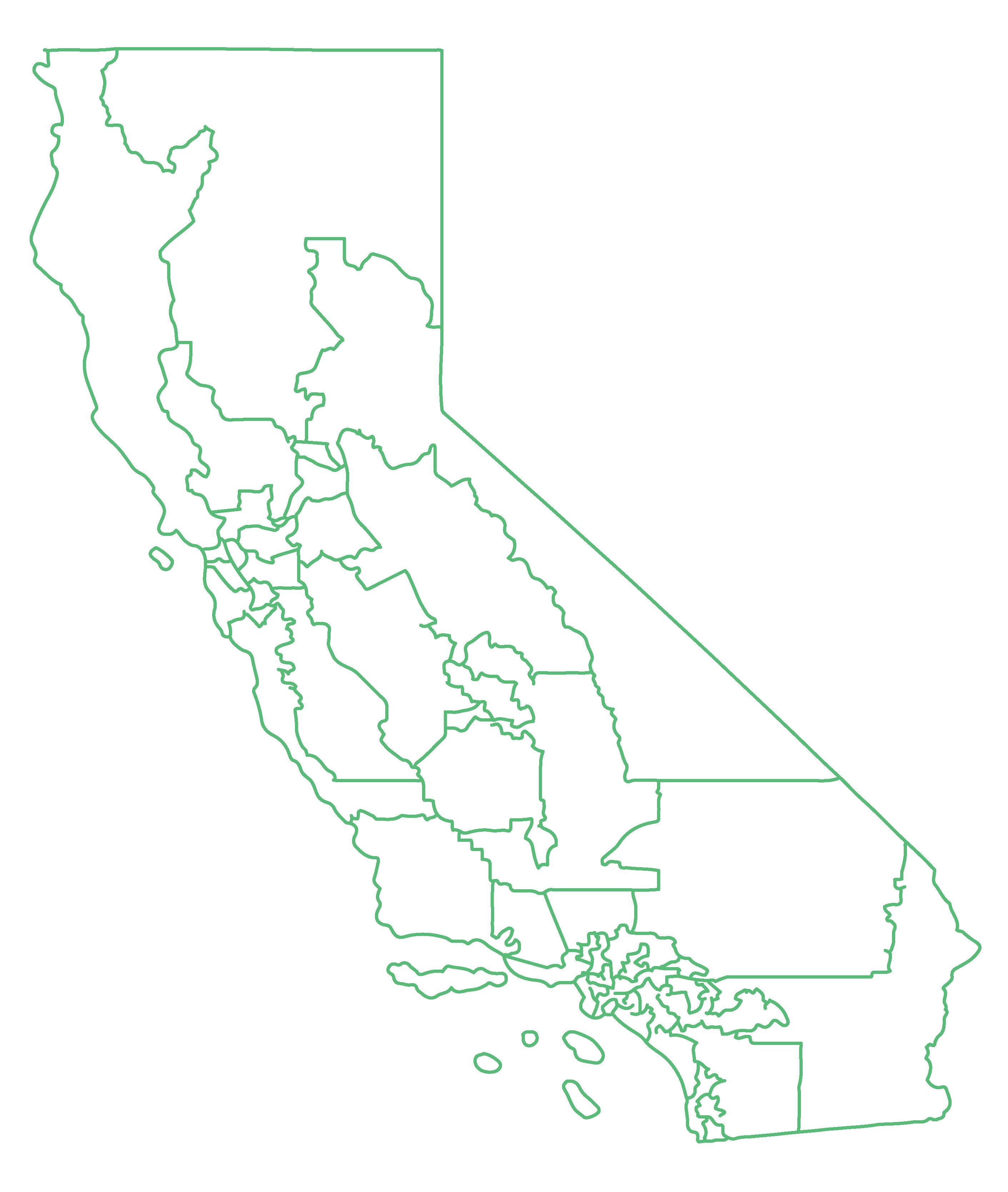

PROPOSITION50
Yes No
Gerrymandering or safeguard? The political clash over Proposition 50
STORY BY MAYA REIKEN DESIGNED BY NHI DUONG
Proposition 50, a recent California ballot initiative, reflects both state politics and the larger national fight for control of Congress.
The proposition addresses congressional district borders, which have an impact on who is elected to the U.S. House of Representatives and which party ultimately controls the House. Republicans hold a narrow majority right now.
Redistricting typically occurs once every ten years, following the U.S. Census, which is scheduled for 2030. In response to pressure from President Donald Trump, the Texas state legislature passed a new plan this year to increase the number of congressional seats for the Republican Party and maintain its majority, as previously reported by The Texas Tribune.
Gov. Gavin Newsom created Proposition 50 in an attempt to give Democrats a comparable advantage in California’s congressional elections and negate Texas’s action.
Newsom signed two bills to redraw congressional districts in favor of Democrats. Unlike Texas, California is supposed to use an independent redistricting commission composed of five Democrats, five Republicans and four independents. The commission aims to provide voters with equitable representation in the State Legislature and the House of Representatives by eliminating politics from the line-drawing process.
In order to create new maps for the upcoming elections, California officials require another vote from the people on Nov. 4. If approved, California would hold congressional elections through 2030 with the updated maps.
Ultimately, Proposition 50 will determine whether California voters will continue the state’s long-standing tradition of nonpartisan redistricting or temporarily abandon it in the face of a national political battle.
Proponents say Proposition 50 is necessary to level the playing field and maintain our democracy.
Proponents include prominent Democratic leaders at the state and federal levels, such as Senator Alex Padilla and Representative Nancy Pelosi. They claim that Proposition 50 is a necessary response to Trump’s intention to weaken democracy and enact more policies that do not accurately represent the wishes of the electorate.
“Proposition 50 is the only democratic, peaceful way to use the power of democracy to fight against autocracy,” said Tom Fulks, chairman of the Democratic Party of San Luis Obispo.
Before Proposition 50, Tom says that Republicans were complaining about how unfair the California Citizens Redistricting Commission is. He says that their current support for it is disingenuous and a smoke screen for their clear attempt to grab power.
Proponents argue that, in the long run, the proposal remains committed to California’s independent redistricting system because it will only be used until 2030.
“We don’t want this fight, and we didn’t choose this fight, but with our democracy on the line, we cannot and will not run away from this fight,” California Democratic Assemblyman Marc Berman said, as California lawmakers approved the legislation on Aug. 18.
Proponents portray Proposition 50 as a targeted and timely defense of democratic fairness, aiming to safeguard the integrity of federal elections and California’s independent redistricting process.
“A smart, measured approach, designed to address a very particular problem in a very particular moment in time,” former President Barack Obama stated at an event for the National Democratic Redistricting Committee.
Opponents say that Proposition 50 will result in the worst partisan gerrymander.
Opponents include Republican leaders in California, such as former Secretary of State Bruce McPherson and Representative Young Kim. They argue that Democrats are asking voters to replace California Citizens Redistricting Commissiongenerated maps that produced fair elections with lines created by politicians. They argue that allowing politicians to discreetly create maps, Proposition 50 eradicates public participation and transparency from the redistricting process, according to the Stop 50 campaign.
“A ‘no’ vote on Proposition 50, which, if passed, would end any possibility of fair elections in California,” said Randall Jordan, chairman of the Republican Party of San Luis Obispo.
He believes Proposition 50 would take the power away from citizens, as currently exercised in the independent citizens’ redistricting commission, and revert this power back to legislators, allowing them to gerrymander districts to favor one political party over another.
In 2008, voters decided the independent commission must stop redistricting in favor of party pref erence. Relinquishing this mandate back to the legislators would reduce competitive elections and strip constitutional protections.
“Once you take away the people’s power, you will never return it to them,” Republican Assemblyman Carl DeMaio said on the Assembly floor, as previously reported by The New York Times.
Opponents largely described Proposition 50 as a “power grab” by Newsom and other Democrats in the state government. They argue that reintroducing congressional maps created by politicians betrays the support of the California people for the establishment of the independent redistricting commission.
With a "yes" vote, California will use new congressional maps drawn by Democratic state officials through 2030, possibly nullifying Texas’s partisan maps and shifting the balance of power in the House of Representatives.
With a "no" vote, nothing would change, and California would continue to hold all congressional elections until 2030 using the congressional maps that were created by the independent commission.



The best Halloween costumes are homemade
OPINION BY MADDIE KUHNS DESIGNED BY JULIA HAZEMOTO
Maddie Kuhns is a journalism senior and Mustang News opinion columnist. The opinions expressed in this article do not necessarily reflect those of Mustang Media Group.
At eight years old, I stood in a doorway with my pillowcase candy bag. I was thrilled to show off my costume: a bat with wings that spread when I put my arms up. My mom had sewed shiny black fabric and wooden sticks together. My grandmother was big on making elaborate costumes for my dad with what she had, so of course it was passed down to my family.
My get-up wasn’t the most trendy. I wasn’t wearing a Spirit Halloween
zombie cheerleader costume like the other kids, but I felt unique. My childhood costumes could be made with what we had or what was easy to get. They didn’t cost a fortune, so it wasn’t as painful to spend money on a one-time use.
Fast forward ten years, as I was standing in front of my dorm room mirror, I was wondering how on Earth I could find a costume in time for a night more thrilling than trickor-treating. To make things even worse, upperclassmen were telling me I had to plan a different costume for each night of the weekend and find a way to pay for it. Thankfully, I quickly learned that San Luis Obispo residents have a plethora of thrift and craft stores at their disposal.
For the uninitiated, Halloween
is not a singular day of celebration at Cal Poly. Students here turn Halloween into a three to four day event called Halloweekend, and the celebration doesn’t stop on Oct. 31.
With multiple days to celebrate, a new issue arises. More than one costume is needed to fit each day.
Just because you are now a grown-up doesn’t mean mom’s homemade fit isn’t still an option for the world’s best costume. Using a combination of thrift shopping, sewing and maybe borrowing from your roommate’s closet, the possibilities are endless.
Sustainable-clothing shopping isn’t just for everyday attire. Extend your love for second-hand items to holidays like Halloween. Not to mention, thrift stores occasionally
carry an array of Halloween costumes from superheroes and clowns to other basic costumes.
Whether your spooky disguise leads you to a classic white sheet ghost or a non-traditional outfit, you can avoid breaking the bank and harming the planet through homemade techniques. Upcycling and a little creativity can bring new life to old clothing without hurting your wallet or our planet.
Speaking of homemade: freshman, when was the last time you called your parents? If you need sewing techniques, you can always ask for some tips. One of the best shared opinions of Cal Poly students is that homemade and thrifted fashion is cool!
A funny/goofy costume
Who doesn’t love a good Guy Fieri wig? Not to mention you can find an old bowler shirt from thrift stores like Fred and Betty’s or Goodwill. Couples: how about changing the classic cute couples costume to something out of the box? My personal favorites are Dobby the Elf and Lucius Malfoy.
A raunchy costume
You’ve been hitting the gym, so show off that body! Essentially any regular costume can be made hot by taking away half of the fabric. Yes, that even means you can turn your funny Guy Fieri into a sultry Guy Fieri, if you’re desperate.
A scary costume
Growing up, scary costumes meant zombie makeup or vampire teeth. Now it may mean something different: a real life fraternity-brother. Get your best backwards hat, khaki shorts, a polo shirt and your gym shoes. Nothing is scarier than a slightly off-beat flick and an empty set of eyes.
A group costume
This is the chance to get your friends together to coordinate a once-in-a-lifetime experience. Maybe you’re all matching, posing as the Penguins of Madagascar with used tuxes. Or you can all fit a theme with your own unique flairs like channeling the Very Hungry Caterpillar and fruit with monochrome outfits.
JDAWG SAYS: Be a gym bro!
You’ll have no friends and no time for other responsibilities, but gains
SATIRE BY JDAWG
DESIGNED BY JULIA HAZEMOTO
The Manure is Mustang News’ satire content. JDAWG SAYS is a satirical advice column written by a staff member in Mustang News. This content is intended to be satirical and does not necessarily represent the views of Mustang News. There are lots of opportunities on our campus that you should take advantage of to get the full Cal Poly student experience, and because we pay hella fees. One of these expenses is a mandatory fee that contributes to the Rec Center, which in my mind means mandatory gains.
Open 6 a.m. to midnight during the week and 8 a.m. to 8 p.m. on the weekends, the Rec Center is full of life, sweat and self-administered hormones nearly around the clock. But being a gym bro is more than literally going to the gym. You need to dedicate all your limited brain power to this lifestyle. If you’re not convinced to enter the gates of gains, read below for some reasons and tips to get you there.


It’s not gay if it’s in the gym
Now, you may be ashamed of your browser history. But in the gym, there is no shame in staring at bulging biceps and glutes. It’s okay if you’re imagining your bros naked within these four walls because it’s in the name of physique inspiration.

If you want rock-hard abs, you need to put in the work. It all starts in the kitchen, which you should largely stay away from. Chicken and rice is no joking matter, and maybe throw in some Zyns for the mood swings.


No luck on the dating apps?
If you’re embarrassed by that muscle in your pants or if your height starts with a five, you can compensate by lifting seven days a week. Instead of working on your personality or insecurities in therapy, just walk on over to the shoulder press.
At the gym, you could be top dog
In this woke world, women and the gays are taking over spaces like no other. But, at the gym, straight men still have the opportunity to really be themselves. Make the most of this sacred space by being loud and exclusive.



Put down the coke and pick up the creatine
Along with muscle growth, studies have shown that creatine consumption can help with brain fatigue and general intelligence… some of you definitely need that, I fear. So put down the cocaine and start doing lines of creatine.
With all the beer you drink…
To work off all those afternoon beers, evening beers, shower beers, pregame beers, postgame beers, sober beers, drunk beers and regular beers, you need to do something with all of those calories. The gym balances out all of your weekend or weekday debauchery.

Get wet even if CA is in a drought
Being a gym bro means you get to sweat all your problems away and add some moisture to the water cycle. From sweat marks left on benches to dripping basketballs, there is plenty of sweat to go around.
Bacne is hot
Don’t shower after your lift, or you’ll miss out on having pimples take over your back. These red dots are important to show your commitment to the gym and help you get your first tren allegation.








